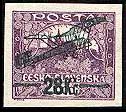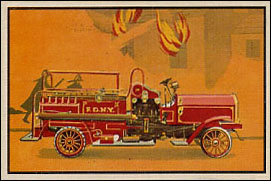|
On the Number 28
| |||||||||||||
|
28 in Mathematics
| |||||||||||||
| 1) | The 14th even number = 28 | ||||||||||||
| 2) |
The 7th triangular numbers = Sum of the first 7 numbers = 1+2+3+4+5+6+7 = 28 | ||||||||||||
| 3) | The 2nd perfect number, = sum of its divisors = 1 + 2 + 4 + 7 + 14 = 28 | ||||||||||||
| 4) |
28 appears as the last digits in the 4th, 7th, and 8th
perfect numbers: 8128, 137438691328, 2305843008139952128 | ||||||||||||
| 5) | The 3rd harmonic divisor number: 1, 6, 28, 140, 270, 496, 672 | ||||||||||||
| 6) | The 3rd Keith number: 14, 19, 28, 47, 61, 75, 197 | ||||||||||||
| 7) | The 3rd primitive semiperfect number: 6, 20, 28, 88, 104, 272, 304, 350 | ||||||||||||
| 8) | The 4th hexagonal number: 1, 6, 15, 28, 45, 66, 91, 120, 153 | ||||||||||||
| 9) | The 9th 2-highly polygonal number: 1, 6, 9, 10, 12, 15, 16, 21, 28 | ||||||||||||
| 10) | The 18th composite number = 28 | ||||||||||||
| 11) | 56/2 = 28; 84/3 = 28; 112/4 = 28 | ||||||||||||
| 12) |
Sum of the 7th & 8th odd numbers = 13 + 15 = 28 Sum of the 6th & 8th even numbers = 12 + 16 = 28 | ||||||||||||
| 13) | Sum of the 1st & 3rd cube numbers = 1 + 27 = 28 | ||||||||||||
| 14) | Sum of the 1st five prime numbers = 2 + 3 + 5 + 7 + 11 = 28 | ||||||||||||
| 15) |
Sum of the 5th & 7th
prime numbers = 11 + 17 = 28 Sum of the 3rd & 9th prime numbers = 5 + 23 = 28 | ||||||||||||
| 16) |
Sum of 3rd composite number
& 3rd abundant number = 8 + 20 = 28 | ||||||||||||
| 17) |
Sum of 7th even number & 7th composite number
= 14 + 14 = 28 | ||||||||||||
| 18) |
Sum of the 2nd and 8th
lucky numbers = 3 + 25 = 28 Sum of the 3rd and 7th lucky numbers = 7 + 21 = 28 Sum of the 5th and 6th lucky numbers = 13 + 15 = 28 | ||||||||||||
| 19) |
Sum of the 3rd, 5th, & 8th Fibonacci numbers = 2 + 5 + 21 = 28 (Leonardo Pisano Fibonacci, 1170-1250) | ||||||||||||
| 20) |
Product of 1st & 7th even numbers = 2 x 14 = 28 Product of 2nd square number & 4th prime number = 4 x 7 = 28 | ||||||||||||
| 21) |
28 appears in the first set of
amicable numbers,
220 and 284. Also in the 7th set: 12285 and 14595 and in the 10th set: 66928 and 66992 More on Amicable Numbers | ||||||||||||
| 22) | Square root of 28 = 5.291502622 | ||||||||||||
| 23) | Cube root of 28 = 3.036588972 | ||||||||||||
| 24) | ln 28 = 3.33220451 (natural log to the base e) | ||||||||||||
| 25) | log 28 = 1.447158031 (logarithm to the base 10) | ||||||||||||
| 26) |
Sin 28o = 0.469471562 Cos 28o = 0.882947592 Tan 28o = 0.531709431 | ||||||||||||
| 27) |
1/28 expressed as a decimal = 0.035714285 | ||||||||||||
| 28) |
Sum of the 1st through 7th digits of pi, π = 28 (π = 3.1415926535; 1+4+1+5+9+2+6 = 28) | ||||||||||||
| 29) |
The 33rd & 34th digits of pi, π = 28 The 73rd & 74th digits of pi, π = 28 The 83rd & 84th digits of pi, π = 28 | ||||||||||||
| 30) |
The 51st & 52nd digits of
phi, φ = 28 The 72nd & 73rd digits of phi, φ = 28 | ||||||||||||
| 31) |
The 4th & 5th digits of e = 28 The 8th & 9th digits of e = 28 (e = 2.7182818284 5904523536) | ||||||||||||
| 32) |
Binary number for 28 = 00011100 (Decimal & Binary Equivalence; Program for conversion) | ||||||||||||
| 33) |
ASCII value for 28 = FS (Hexadecimal # & ASCII Code Chart) | ||||||||||||
| 34) |
Hexadecimal number for 28 = 1C (Hexadecimal # & ASCII Code Chart) | ||||||||||||
| 35) |
Octal number for 28 = 034 (Octal #, Hexadecimal #, & ASCII Code Chart) | ||||||||||||
| 36) | The Greek-based numeric prefix octaicosa- means 28. | ||||||||||||
| 37) | The Latin-based numeric prefix octoviginti- means 28. | ||||||||||||
| 38) | The Roman numeral for 28 is XXVIII. | ||||||||||||
| 39) |
 Èr Shí Ba
is the Chinese ideograph for 28.
Èr Shí Ba
is the Chinese ideograph for 28.
| ||||||||||||
| 40) |
 is the
Babylonian number for 28.
is the
Babylonian number for 28.
| ||||||||||||
| 41) |
28 in different languages: Dutch: twintig-acht, French: vingt-et-huit, German: achtundzwanzig, Hungarian: húsz-nyolc, Italian: venti-otto, Spanish: veinte-ocho, Swahili: ishirini-nane, Swedish: tjugu-atta | ||||||||||||
| 42) |
The Arab alphabet has 28 letters | ||||||||||||
| 43) |
The Runik alphabet, also called Futhark, has 28 letters It was used by Germanic peoples of northern Europe, Britain, Scandinavia, and Iceland (3rd century to the 16th or 17th century AD). | ||||||||||||
| 44) |
28 digits = one Egyptian royal cubit. A digit (19 mm) is the width of one finger. A cubit is the distance between the elbow to the fingertips. Richard Phillips, Numbers: facts, figures and fiction, Cambridge University Press, 1994, p. 32 | ||||||||||||
| 45) |
Hebrew numerology, Gematria:
Koach
(Power, Strength) or KCh adds to 20 + 8 = 28 It is used in Amos, 2.14: "Therefore the flight shall perish from the swift, and the strong shall not strengthen his force, neither shall the mighty deliver himself." (Hebrew words that add up to 28; Gematria Server) | ||||||||||||
| 46) |
In Hebrew, the first verse of the Bible "In the beginning God created the heavens and the earth" (Genesis I.1) has seven words and 28 letters. | ||||||||||||
|
28 in Science
| |||||||||||||
| 47) |
The 4th physics magic number: 2, 8, 20 28, 50, 82, 126 In nuclear physics, a "magic number" is a number of nucleons such that they are arranged into complete shells within the atomic nucleus. | ||||||||||||
| 48) | Sum of the faces in an octahedron & an icosahedron = 8 + 20 = 28 | ||||||||||||
| 49) | Sum of the vertices in a cube & an docahedron = 8 + 20 = 28 | ||||||||||||
| 50) |
Solar Rotation:
At the equator, the sun rotates on its axis once every 27 days. But because it is not solid, other regions move at different speeds. It takes 35 days to make a full rotation near the poles. Rachel Howe reports in Science (March 31, 2000) that the rotation rates vary inside the sun. The outer third of the sun moves energy toward the surface by convection, a method of heat transfer that relies on the fact that heat rises. Below this convective zone is a region where energy moves outward via radiation. Where the convective and radiative zones meet is a border region known as the tachocline. The new findings show that just above and below the tachocline, and close to the sun's equatorial plane, the rotation rate speeds up and slows down rhythmically every 16 months. The region just above the border moves at about 45,900 feet (1,400 meters) per second, rotating once every 26 days, said Howe, who works at the National Solar Observatory in Tucson, Arizona. Just below the border, gas moves at 40,000 feet (1,200 meters) per second, requiring about 28 days to make a rotation. | ||||||||||||
| 51) |
The moon completes 4 phases once it has wandered through the
28 lunar mansions. Annemarie Schimmel, The Mystery of Numbers, Oxford Univesity Press, 1993, p. 239 | ||||||||||||
| 52) |
Average human menstrual cycle in women is 28 days. | ||||||||||||
| 53) |
Skin research has discovered that the epidermis is constantly regenerating itself, and all of its cells are replaced every 28 days. Annemarie Schimmel, The Mystery of Numbers, Oxford Univesity Press, 1993, p. 239 | ||||||||||||
| 54) |
For most people, 28 permanent teeth have emerged by age 14, while the last four third molars, the wisdom teeth, erupt only if the jaw allows space for them. ( NIH Lesson for students on teeth and mouth) | ||||||||||||
| 55) |
 The Twenty-eight Parrot
The Twenty-eight Parrot(Barnardius zonarius semitorquatus) is found in south-west West Australia. It has a black head, a green patch on the belly. Its crying call consists of three syllables that sounds like "28". | ||||||||||||
| 56) | Biorhythmic Cycles: Physical 23 days, Emotional 28 days, Intellectual 33 days. | ||||||||||||
| 57) |
Atomic Number of
Nickel (Ni) = 28 (28 protons & 28 electrons) Nickel is a silvery white metal that takes on a high polish. It is hard, malleable, ductile, somewhat ferromagnetic, and a fair conductor of heat and electricity. Nickel is found as a constituent in most meteorites. The U.S. 5¢ coin (whose nickname is "nickel") contains just 25% nickel. | ||||||||||||
| 58) |
Atomic Weight of
Silicon (Si) = 28 (28.0855) Silicon is present in the sun and stars and is a principal component of a class of meteorites known as aerolites. Silicon makes up 25.7% of the earth's crust by weight, and is the second most abundant element, exceeded only by oxygen. It is found largely as silicon oxides such as sand (silica), quartz, rock crystal, amethyst, agate, flint, jasper and opal. Silicon is found also in minerals such as asbestos, feldspar, clay and mica. (Silicon Numerology) | ||||||||||||
| 59) |
Molecular weight of nitrogen, N2 = 28.02 Total Molecular Mass of Air = 28.97 Molecular weight of carbon monoxide, CO = 12 + 16 = 28.01 It's interesting that while carbon monoxide is poisonous, nitrogen is essential to life, yet they have the same molecular weight of 28 daltons. | ||||||||||||
| 60) | Organic compounds whose melting point = 28oC: Bromo iodo-ethane (1,2), BrCH2-CH2I, MP = 28oC Diethanolamine, HN(CH2-CH2OH)2, MP = 28oC Ethoxy-phenol (o), C2H5O-C6H4-OH, MP = 28oC Methyl-phenol (o), CH3O-C6H4-OH, MP = 28.3oC Methyl acetamide (N), CH3-CO-NH-CH3, MP = 28oC Methyl acetophenone (p), CH3-C6H4-CO-CH3, MP = 28oC Methyl toluene sulfonate, CH3-C6H4-SO3CH3, MP = 28oC Nitro furan (2), NO2-C4H3O, MP = 28oC Octa-decane, CH3-(CH2)16-CH3, MP = 28.0oC Phorone, [(CH3)2C=CH]2CO, MP = 28oC [Norbert A. Lange, Handbook of Chemistry, Sandusky, Ohio (1952)] | ||||||||||||
| 61) | Melting point of butter = 28oC to 36oC. | ||||||||||||
| 62) |
The 28th amino acid in the 141-residue alpha-chain of Human Hemoglobin is Alanine (A) The 28th amino acid in the 146-residue beta-chain of Human Hemoglobin is Leucine (L) Single-Letter Amino Acid Code Alpha-chain sequence of human hemoglobin: VLSPADKTNVKAAWGKVGAHAGEYGAEALERMFLSFPTTKTYFPHFDLSH GSAQVKGHGKKVADALTNAVAHVDDMPNALSALSDLHAHKLRVDPVNFKL LSHCLLVTLAAHLPAEFTPAVHASLDKFLASVSTVLTSKYR Beta-chain sequence of human hemoglobin: VHLTPEEKSAVTALWGKVNVDEVGGEALGRLLVVYPWTQRFFESFGDLST PDAVMGNPKVKAHGKKVLGAFSDGLAHLDNLKGTFATLSELHCDKLHVDP ENFRLLGNVLVCVLAHHFGKEFTPPVQAAYQKVVAGVANALAHKYH | ||||||||||||
| 63) |
"Haemoglobin Genova: β28 Leu—> Pro" G. Sansone, R. W. Carrell, and H. Lehmann, Nature Vol. 214, 877-879 (1967) An unstable haemoglobin with the electrophoretic properties of normal adult hemoglobin A has been identified in a Genovese family with severe haemolytic anaemia. It differs from A by the substitution in its β-chain of Proline for Leucine at position 10 of the B-helix. This substitution accounts for the disease in molecular terms because Proline would interrupt the helical configuration. The B-helix of the human Β-chain contains 16 residues (19-34), and residue B10 is therefore placed towards the middle of the helix. On a model it is seen to occupy an internal site. (Note: The Chou-Fasman helical potentials Pα for Leu & Pro are 1.21 & 0.57 respectively, so the helical conformation is disrupted in this region.) [ A new case of Hemoglobin Genova, Biochim. Biophys. Acta, 295, 67-76 (1973)] | ||||||||||||
| 64) |
The 28th amino acid in the 153-residue sequence of
sperm whale myoglobin is Isoleucine (I) [A.B. Edmundson, Nature 205, 883-887 (1965)] Sequence alignment of myoglobin from 26 species by Margaret O. Dayhoff [Atlas of Protein Sequence and Structure (1978), p. 235] shows conservation of Val-28 in 23 species including human, badger, chicken, dog, rabbit, horse, bovine, sheep, pig, opossum, platypus, red kangaroo, and European hedgehog. Three exceptions: California gray whale, sperm whale, and slow loris with Ile-28 instead of Val-28. (Note: The Chou-Fasman helical potentials Pα for Ile & Val are 1.08 & 1.06 respectively, so the helical conformation is conserved in this region.) | ||||||||||||
| 65) |
The 28th amino acid in the 32-residue sequence of
calcitonin is Glycine. Sequence alignment of calcitonin by Margaret O. Dayhoff [Atlas of Protein Sequence and Structure, Vol. 5, Suppl. 3 (1978), p. 149] shows conservation of Gly-28 in all 9 species— human, bovine, sheep, pig, rat, eel, and salmon 1-3. European J. Biochem. 269, 780-791 (2002) | ||||||||||||
| 66) |
The 28th amino acid in the 29-residue sequence of
glucagon is Asparagine. Sequence alignment of glucagon by Margaret O. Dayhoff [Atlas of Protein Sequence and Structure, Vol. 5, Suppl. 1 (1973), p. S-52] shows conservation of Asn-28 in human, bovine, pig, rabbit, and rat. Turkey and duck glucagon have Serine-28 instead of Asn-28. | ||||||||||||
| 67) |
The 28th amino acid in the 124-residue enzyme
Bovine Ribonuclease is Glutamine (Q). It is next to Asparagine-27 and Methione-29. [C. H. W. Hirs, S. Moore, and W. H. Stein, J. Biol. Chem. 235, 633 (1960)] | ||||||||||||
| |||||||||||||
| |||||||||||||
| |||||||||||||
| 74) |
Somatostatin is a peptide hormone containing a mixture of SS-14 with 14 amino acids, and SS-28 with 28 amino acids. Somatostatins regulate the modulation of growth, development, and metabolism. The different forms of somatostatin observed in mammals (e.g., SS-28) are N-terminal extensions of SS-14 and result from differential processing of the same precursor, preprosomatostatin I. "Structure-Function Relationships of the Signaling System for the Somatostatin Peptide Hormone Family" [Mark A. Sheridan, et. al., American Zoologist, 40, 269-286 (1999)] | ||||||||||||
| 75) |
Bend Positional Frequencies in 29 proteins: Valine (Val): f(i+2) = 0.028 [from Table VIII (p. 71) of P.Y. Chou & G.D. Fasman, Advances in Enzymology 47, 45-148 (1978)] | ||||||||||||
| 76) |
At about 18,000 to 19,000 light years distance,
Messier object M28 with its linear diameter of 60 light years appears considerably smaller and more compressed than its more impressive neighbor, M22. It is slightly elliptical shaped according to H. Shapley. Globular cluster M28 in Sagittarius is one of the discoveries of Charles Messier, who cataloged it on July 27, 1764. | ||||||||||||
| 77) |
 The Sombrero galaxy
is on the southern edge of the rich Virgo cluster
The Sombrero galaxy
is on the southern edge of the rich Virgo clusterof galaxies and is one of the most massive objects in that group, equivalent to 800 billion suns. The galaxy is 50,000 light-years across and is located 28 million light years from the earth. The majestic spiral arms cannot be seen in this side view of the Sombrero, named because it resembles a broad-brimmed Mexican hat. Hubble Heritage Picture - October 2003: M104, aka Sombrero Galaxy, aka NGC 4594— a spiral galaxy, 28 million light-years from Earth. | ||||||||||||
| 78) |
28 billion light years is the distance of our universe from edge to edge. Cosmic Microwave Background: The New Cosmology How Can Any Object Be 28 Billion Light Years Away? The Horizon Problem: two edges are nearly 28 billion light years apart, and our universe is only 14 billion years old. | ||||||||||||
| 79) |
The New General Catalog (NGC)
is a listing of nearly 8,000 non-stellar objects, such as star clusters, nebulae, and galaxies, compiled by J.L.E. Dreyer (1887). NGC 28 is an elliptical galaxy in the constellation Phoenix. | ||||||||||||
| 80) |
28 Bellona is a large main belt asteroid
between Mars and Jupiter. Bellona was discovered by R. Luther on March 1, 1854. It is named after Bellona, the Roman goddess of war; the name was chosen to mark the beginning of the Crimean War. Its diameter is 120.9 km, rotation period of 15.7 hours, and orbital period of 4.63 years. | ||||||||||||
| 81) | Volume 28 of
Scientific American (1873)—
a Weekly Journal of Practical Information, Art, Science, Mechanics, Chemistry, and Manufactures published weekly by Munn & Co., 37 Park Row, New York (No. 1-25, Jan. 4-June 28, 1873), pp. 1-414 (subscription: $3/year) [Stanford Library: T1.S5N.S.V28.1873] Interesting articles in Volume XXVIII: 1) "The Largest Refracting Telescope" Scientific American, XXVIII, 1 (Jan. 4, 1873) [The British made 25-inch lens has a magnifying power 3000 times, exceeding the next largest telescope at the Chicago Observatory.] 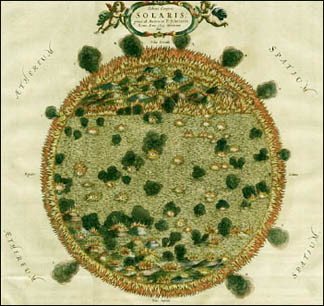 2) "Professor Tyndall's 4th Lecture in New York— Polarized Light"
2) "Professor Tyndall's 4th Lecture in New York— Polarized Light"Scientific American, XXVIII, 51 (Jan. 25, 1873) [Article followed by quote: "There is a great difference between two temporal blessings, health & wealth; wealth is most envied, but least enjoyed; health is frequently enjoyed, but the least envied; and the superiority of the latter is still more obvious when we reflect that the poorest man would not part with his health for money, but that the richest would gladly part with his money for health."] 3) "Kircher's Remarkable Observations Concerning the Sun Scientific American, XXVIII, 193-194 (March 29, 1873) [Reproduced here is an engraving made in 1682 by Father A. Kircher of Holland. His drawing shows the dark sunspots and ten protuberances, a remarkable observation of the solar surface before modern astronomers.] 4) "Central Park, New York City" Scientific American, XXVIII, 263-264 (April 26, 1873) Seven engravings from sketches of the loveliest portions of Central Park are shown: Bow Bridge, Boat House, Bird Cage, The Spring, Summer House, Rustic Seat & Fountain, Echo Bridge. | ||||||||||||
| 82) |
Volume 28 of
Nature (1883)— A Weekly Illustrated Journal of Science was published by Macmillan & Co., London (May 3, 1883 to October 25, 1883), pp. 1-632 Wordsworth epigraph on cover: "To the solid ground Of Nature trusts the mind which builds for aye." Three interesting articles in Nature XXVIII: .jpg) 1) G.J. Symons, "Zodiacal Light: Sun Pillar", Nature XXVIII, 6-7 (May 3, 1883):
1) G.J. Symons, "Zodiacal Light: Sun Pillar", Nature XXVIII, 6-7 (May 3, 1883):the phenomenon described under the heading "The Zodiacal Light (?)" was that generally known as a "Sun Pillar". I send herewith an engraving of one seen from Sidmouth (April 4, 1871), full descriptions of which were given in the Meteorological Magazine for May, June, and July of that year. I believe that it is merely a portion of a halo passing vertically through the sun; in the recent case, that portion of the halo which was above the sun was alone seen, sometimes the portion below it is seen alone, and occasionallyboth are visible, together with a parlelic circle (or parts of one), and then of course we have the rare phenomenon of the sun as the center of a luminous cross. (Sun Pillar: March 13, 2001) 2) Sir William Thomson, (Lord Kelvin) "The Size of Atoms" Nature XXVIII, 203-205 (June 28, 1883), 250-254 (July 12, 1883), 274-278 (July 19, 1883) I wish in the beginning to beg you not to run away from the subject by thinking of the exceedingly smallness of atoms. Atoms are not so exceedingly small after all... the molecules which constitute the air we breathe are not very much smaller, if smaller at all, than 1/10,000,000 of a centimetre in diameter... Somebody tells me the millimetre is not there; I cannot see it, but it certainly is there, and a circle whose diameter is a millimetre, both accurately painted in black. I say there is a millimetre andy you cannot see it. And now imagine there is 1/10 of a millimetre, and there 1/100 of a millimetre and 1/1000 of a millimetre, and there is a round atom of oxygen 1/1,000,000 of a millimetre in diameter. You see them all. 3) "The Java Eruption" Nature XXVIII, 577 (Oct. 11, 1883): The following details concerning this catastrophe have been sent by Lloyd's agents at Batavia, on Sept.1— "The past week is memorable as having witnessed one of the most disastrous and severe volcanic eruptions ever known in the Malay archipelago. Krakatoa has again been the origin of the disturbance. On Sunday last, about 4 pm, a series of detonations were heard proceeding apparently from the south-west. Towards night these grew louder, till in the early morning the concussions were simply deafening, not to say alarming. When day broke the atmosphere to the west had a sulphurous and lurid appearance, and a thin layer of fine white ash covered the ground... About 12 o'clock (midday) a large wave about 17 feet in height swept in from the sea,... Shortly after 2 pm, another wave, larger than the first, came rolling in from the sea... The Island of Krakatoa, the summit of which peak was 2600 feet above water level, has totally disappeared below the sea, and the neighboring Island of Dwaisindeweg is split in five parts. Sixteeen new volcanic islands have been formed between Krakatoa and Sibesie, and the sea bottom in the Straits of Sunda has completely changed... in the residence of Tjeringin alone 10,000 lives were lost. The Padang steamer reports that it is impossible to approach to the place where Telok Betong once was situated, owing to the sea being filled with pumice stone and mud. In some parts of Sumatra Straits the pumice stone is seven to eight feet deep. Krakatoa Eruption of August 26, 1883 | ||||||||||||
| 83) | Volume 28 of
Science (1908)— a Weekly Journal devoted to the Advancement of Science was published by The Science Press, New York (July-December 1908), pp. 1-936 Interesting articles in this volume: 1) Wilmont E. Ellis, "A Study of the Remarkable Illumination of the Sky on March 27, 1908" Science XXVIII, 51-53 (July 10, 1908) On the night of Friday, the 27th of March, 1908, between the hours of 7:45 and 8:30, there was an unusual illumination of the heavens. the display was noted by many observers at Sandy Hook, NJ and at Montclair, NJ. It was a warm day, above 70o. The evening was also clear, but cooler. There was no moon, but Venus shone unusually bright in the western sky. The illumination consisted of a bright nebulous band rising north of west from about 20o above the horizon. The light extended across the sky to near the north of east horizon, diminishing in brightness from the sky from west to east. The hypothesis here offered seems to account for the puzzling mixed spectra of the so called zodiacal light. 2) G.K. Gilbert, "Evolution of Niagara Falls" Science XXVIII, 148-151 (July 31, 1908) Reviews J.W. Spencer's 1907 book Falls of Niagara: Based on the rate of recession, the age of Niagara Falls would have been nearer 20,000 than 39,000 years. 3) Thomas B. Osborne, "Our Present Knowledge of Plant Proteins" Science XXVIII, 417-427 (October 2, 1908) The seeds of cereals, with the probable exception of rice, contain a small amount of proteose, albumin, and globulin, and relatively considerable quantities of prolamin soluble in alcohol, and of glutelin insoluble in neutral solvents. 4) Spencer Trotter, "Concerning the Real Unicorn" Science XXVIII, 608-609 (October 30, 1908) Ctesias describes the one-horned beast graven on the walls of the Persian court at Persopolis and gave the name "unicorn" or "monoceros". | ||||||||||||
| 84) |
Volume 28 of
Journal of Mental Science (1883) was published by the Medico-Psycholical Association, London (No. 121-124, April 1882-January 1883), pp. 1-664 Editors: D. Hack Tuke & George H. Savage Interesting articles in this volume: 1) David Nicolson, "Some Observations on the State of Society, Past and Present in Relation to Criminal Psychology" Journal of Mental Science, Vol. XXVIII, 6-16 (April 1882) Journal of Mental Science, Vol. XXVIII, 510-519 (Jan. 1883) Historical survey of how society deals with witchcraft & demonology. 2) William W. Ireland, "On the Character and Hallucinations of Joan of Arc" Journal of Mental Science, Vol. XXVIII, 483-492 (Jan. 1883) "When she saw the English soldiers lying wounded she had great compassion, and would get them a confessor... no one, whether friend or foe, seems to have thought her insane... Her virginity was beyond dispute, but menstruation seems never to have occurred." 3) George J. Romanes, "Animal Intelligence" Journal of Mental Science, Vol. XXVIII, 603-607 (Jan. 1883) | ||||||||||||
| 85) |
Volume 28 of
Journal of the American Medical Association (1897), published by American Medical Association Press, Chicago, (January-June 1897), pp. 1-1254 Official Journal of the Philosophy of Science Association Editor: John B. Hamilton Interesting articles in this volume: 1) Edward L. Munson, M.D. (Assistant Surgeon, U.S. Army) "The Chemistry of Urine in Diabetes Mellitus" JAMA, Vol. XXVIII, 831-836 (May 1, 1897) "On the Treatment of Diabetes Mellitus by a Diet from which All Carbohydrates Have Been Excluded" JAMA, Vol. XXVIII, 922-929 (May 15, 1897) Conclusion: Sugar is always present in the blood. The absence of carbohydrates from the diet does not cause a disappearance of the blood sugar Hence sugar must have some other source than the carbohydrates ingested. 2) John A. Cutter, "Correspondence: Food for Diabetes" JAMA, Vol. XXVIII, 1041-1042 (May 29, 1897) American morphologists have shown for over 30 years that starches & sugars promote alcoholic & acetic acid fermentation in the stomach and bowels. These facts have been confirmed by German chemists. Victor Hugo, in 1862, in his great work, Les Misérables, called attention to the kinship of consumption and diabetes, and to the role that sugar and sweets play in acid fermentations, and as a cause of these two diseases. Now, I feed beef in chronic cases because it has all the chemic elements necessary to nourish the body, and if good beef is rightly prepared, it digests easiest, and can be borne longer as a single article of food than any other element I know of. 3) Edward L. Munson, "Correspondence: Food for Diabetes. A Reply to Dr. Cutter" JAMA, Vol. XXVIII, 1200 (June 19, 1897) Dr. Cutter's communication in the May 29 issue of JAMA should not pass without a reply. i would beg Dr. Cutter to name his authorities for his claims. Foster's Physiology doesn't recognize the morphologists claim of fermentation in the stomach. It is certainly somewhat extraordinary for a physician to appeal to a layman [Victor Hugo] as an authority on a professional subject. Dr. Cutter believes in an exclusive beef diet as a panacea. In this he is opposed by all physiologists to whose works I have access. | ||||||||||||
| 86) |
Volume 28 of
Journal of Medical Education (1953), official publication of the Association of American Medical Colleges 185 N. Wabash Ave., Chicago 1, Illinois (No. 1-12, Jan.-Dec. 1953) Editor: Dean F. Smiley Interesting articles in this volume: 1) Lawrence S. Kubie, "The Problem of Maturity in Psychiatric Research" Journal of Medical Education, Vol. 28, No. 10, 11-27 (Oct. 1953) 2) Grover F. Powers, "Some Observations on Pediatric Education" Journal of Mental Science, Vol. 28, No. 8, 11-19 (Aug. 1953) Quotes Socrates: When asked whether virtue is acquired by teaching or by practice, Socrates replied "Virtue come to the virtuous by the gift of God." Quotes Robert Frost: "We dance in a ring and suppose / But the Secret sits in the middle and knows." Quotes Emerson: "That which we are, we shall teach, not voluntarily but involuntarily." Quotes Abraham Flexner: "There are men who teach best by not teaching at all." | ||||||||||||
| 87) |
Volume 28 of Isis (1938) was published by the Saint Catherine Press, 51 Tempelhof, Bruges, Belgium (No. 76-77, February & May 1938), pp. 1-619 International Review devoted to the History of Science and Civilization Founded & Edited by George Sarton Interesting articles in this volume: 1) Tenney L. Davis (Massachusetts Institute of Technology), "Pictorial Representations of Alchemical Theory" Isis, Vol. XXVIII, 73-86 (Feb. 1938) The alchemists, Chinese and European alike, were attempting by chemical methods to prepare the elixir and to produce real gold by bringing about the proper combination of the two principles which they considered to be the fundamental basis of all material things. 2) George Sarton (Harvard University), "A Story of the Arabian Nights" Isis, Vol. XXVIII, 321-329 (May 1938) We do not know what was the nature of the stupefying food fed to Sinbad's shipwrecked sailors, but the food distributed by totalitarian states to their people is called "propaganda", the extensive and exclusive diffusion of one-sided news by the press, the wireless and by every other conceivable means. Such food does not fatten the body, as in the Arabian story, but it gradually stupefies the mind and undermines the individual conscience. The victims will not be eaten by cannibals; but are saved for butchery on the battlefield and for all the miseries and ignominies of war. 3) Arthur John Hopkins (Amherst College), "A Defence of Egyptian Alchemy" Isis, Vol. XXVIII, 424-431 (May 1938) Islamic and Latin alchemy owed their beginning to Zosimus's alchemical writings in Egypt. 4) George Sarton, "Book Reviews: Eve Curie's Madame Curie; Marie Curie's Pierre Curie Isis, Vol. XXVIII, 480-486 (May 1938) The lives of Pierre & Marie Curie should be read in the same spirit as people read the live of the saints. I expect my Harvard students to read and ruminate their lives; it may awaken in them, the love of truth and the love of science. (Photo of Pierre at age 46 with autograph and photo of Marie Curie received in 1924 at age 57) | ||||||||||||
| 88) |
Volume 28 of
Philosophy of Science (1961) was published by Saint Catherine Press, Bruges, Belgium (No. 1-4, January-October 1961), pp. 1-453 Official Journal of the Philosophy of Science Association Editor-in-Chief: Richard S. Rudner Interesting articles in this volume: 1) Thomas M. Nelson & S. Howard Bartley (Michigan State University) "Numerosity, Number, Arithmetization, Measurement and Psychology" Philosophy of Science, Vol. XXVIII, 178-203 (April 1961) It is numerosity, not number, that is discriminative in nature. 2) James K. Feibleman, "The Scientific Philosophy" Philosophy of Science, Vol. XXVIII, 238-259 (July 1961) In the dialectic of science and society, society first benefits from the rapid progress of science and only afterwards suffers, when it brings the science | ||||||||||||
| 89) |
Volume 28 of
Journal of Molecular Biology (1967) was published by Academic Press, London & New York (Aug. 28, 1967 to Sep. 28, 1967), pp. 1-544 Published three times a month at 24-28 Oval Road, London NW1 7DX, England by Academic Press, Inc. (London) Editor-in-Chief: J. C. Kendrew Two interesting articles on protein structures in this volume: 1) Hilary Muirhead, Joyce M. Cox, L. Mazzuaella, & M. F. Perutz "Structure and Function of Haemoglobin III: A Three-dimensional Fourier Synthesis of Human Deoxyhaemoglobin at 5.5 Å Resolution" J. Mol. Biol. 28, 117-156 (1967) The tertiary structures of the α- and β-chains closely resemble those of horse oxyhaemoglobin. No shift of the haem groups relative to their own globin chains can be seen. The quaternary structure on the other hand, is markedly different from that of horse oxyhaemoglobin... difference in structure must be due to the reaction with oxygen. 2) B.F.C. Clark, "A Prerequisite Stage in the Initiation of Polypeptide Chains" J. Mol. Biol. 28, 167-169 (1967) Binding of Met-tRNA to ribosomes by the triplet AUG is essential prior to first peptide bond formation in polypeptide chain initiation. | ||||||||||||
| 90) |
.jpg) Fokker F-28 Fellowship jet was developed in Holland (1964)
Fokker F-28 Fellowship jet was developed in Holland (1964)to complement Fokker's highly successful F-27 turboprop. First time flight on May 9, 1967. Flight crew of two with maximum seating for 85. Wing span 25.07 m (82 ft 3 in), Length 27.4 m (89 ft 11 in), Height 8.47 m (27 ft 10 in). Total Fokker F-28 sales of 241 with 160 in commercial service (1998), 10 were used as corporate jets. Fokker F-28 shown on a 40¡ Nauru stamp. Postage stamps with Fokker airplanes | ||||||||||||
| 91) |
T-28 Trojan is a training military aircraft. In 1948 the U.S. Air Force originaly acquired the T-28A as a trainer to replace the venerable AT-6. The T-28B and T-28C were acquired by the U.S. Navy and included a tailhook for carrier landing training. T-28 was shown on Card #15 of Topps Wings: Friend or Foe (1952). | ||||||||||||
| 92) |
The Soviet T-28
multi-turret medium battle tank was a symbol of the Red Army as was his heavier "brother" the T-35. Its silhouette is well known from pre-war newsreel about Soviet military parades in Moscow's Red Square. 41 T-28 tanks were built in 1933 with hightest production of 131 in 1939. In the summer of 1941, the design of the T-28 became obsolete due to the drawbacks of multi-turret vehicles. The T-28 could hit any German tank from long distances. | ||||||||||||
|
28 in Mythology & History
| |||||||||||||
| 93) |
28 Symbolism: According to mystics: one whose name corresponds to the number has good judgment, is inventive and a money-maker. Physical weak spot: head and lungs. According to the cabala: protects against fire, the traits are intelligence and simplicity; in low form: quarrels. In China the number of constellations or the divisions of the celestial sphere subdivided into four sections, the equivalent of the four directions and four seasons presided over by Azure Dragon, Black Tortoise, Phoenix, White Tiger. Also number of days of the lunar month, the 4th, 11th, 18th, and 25th being sun days, equivalent to the western sabbaths. In Egyptian antiquity, age at which the sacred bull Apis was drowned, representing the moon's phases. In Sumer the 28th day of the month was one of sack-cloth and ashes, suggesting mourning. — Gertrude Jobes, Dictionary of Mythology, Folklore and Symbols Scarecrow Press, New York, 1962, Part 2, p. 1613 | ||||||||||||
| 94) |
There are 32 Paths of Wisdom in the
Sepher Yetzirah or
Book of Formation (200 AD). The 28th Path is the Natural Intelligence, and is so called because through it is consummated and perfected the nature of every existent being under the orb of the Sun, in perfection. The Vibrations are Solar. Isidore Kozminsky, Numbers: Their Meaning and Magic, Rider, London, 1912, p. 48 Order of the Golden Dawn: The Zodiacal Sign of Aquarius is the Sign attributed to the 28th Path. | ||||||||||||
| 95) |
The basic pattern of the ganachakra has 12 large lotuses, each with 28 petals. In the center of each flower a god and a goddess embrace one another, all around them sit 28 goddesses grouped into three rows. Victor & Victoria Trimondi, The Shadow of the Dalai Lama, Part I.9. The ADI Buddha: The mandala principle and the world ruler. | ||||||||||||
| 96) |
The Kalachakra Mandala: The best known form of the Kalachakra mandala is the sand mandala. The Body Mandala represents the Form Body of the Buddha (rupakaya) and it surrounds the Speech Mandala. The Body Mandala is placed on the ground level. Including the deities in the surrounding cemetary grounds (depicted as wheels), it contains 536 deities. On the white ledge (lhanam) just inside the outer walls, are 12 animals (visible on the sand mandala, not here), depicting the 12 months of the year. Each carries a lotus with 28 petals on which a deity is placed, and a deity pair in the centre which represents new moon and full moon; together these represent the 30 lunar days in a month. The number 360 also refers to the sets of 360 breaths we take in 60 cycles every day (adding up to 21,600 breaths per day) | ||||||||||||
| 97) |
The Egyptian
Thousand Songs of Thebes (circa 1300 BC) consists not of 1000 but only of 28 poems. Chapter 1000 is actually the 28th chapter. Annemarie Schimmel, The Mystery of Numbers, Oxford Univesity Press, 1993, p. 239 Adolf Erman, The Literature of the Ancient Egyptians (1927), pp. 293-302 William Simpson (Ed.), The Literature of Ancient Egypt, Yale University Press (2003) | ||||||||||||
| 98) |
A monument to Mithras in Siebenburgen, Germany, repeats in 4x7 fields a dagger, a fire altar, a phrygian cap, and a cypress, totaling 28 objects connected with the Mithraic cult. Annemarie Schimmel, The Mystery of Numbers, Oxford Univesity Press, 1993, p. 239 | ||||||||||||
| 99) |
Albertus Magnus (1193-1280) notes that the mystical body of Christ in the Eucharist appears in 28 phases. Annemarie Schimmel, The Mystery of Numbers, Oxford Univesity Press, 1993, p. 238 | ||||||||||||
| 100) |
As a lunar number, 28 plays an important role in Islam, for mystics connect the 28 letters of the Arabic alphabet, in which the divine word, the Quran, is written, with the lunar mansions. The Persian mathematician & historian al-Biruni (973-1048) claims that this relationship proves the close connection between the cosmos and the word of God. It fits well into this picture that the Quran names 28 prophets before Muhammad, and poets therefore compare the Prophet of Islam to the full moon. Annemarie Schimmel, The Mystery of Numbers, Oxford Univesity Press, 1993, p. 239 | ||||||||||||
| 101) |
In his Fusus al-Hikam (Bezels of Wisdom),
Ibn al-Arabi (1165-1240) summarizes the teachings of 28 prophets, from Adam to Muhammad, who dictated them to him in a dream. | ||||||||||||
| 102) |
Sabian symbol of Pisces 28o: A fertile garden under the full Moon reveals a variety of full-grown vegetables: the full satisfaction of the individual's basic needs. Dan Rudhyar, An Astrological Mandala: The Cycle of Transformations and its 360 Symbolic Phases, Vintage, New York (1973), p. 286 (Image) | ||||||||||||
| 103) |
The term "lunar mansion" or Hsiu
(Xiu) can refer either to one of the 28 constellations of the "lunar zodiac" or to one of the 28 segments of the sky containing those constellations which the moon encounters on its passage through the sky in 28 days. Derek Walters, Chinese Astrology, Watkins, London, 2002, pp. 81-82 "Xu Xiu" is one of the 3 Chinese constellations that overlaps Aquarius. It's the northmost of the 28 lunar mansions, or Xiu (also spelled Hsiu), and the center of the Black Tortoise of the North. Xu means "emptiness". | ||||||||||||
| 104) |
 There are 36 Angel Cards
There are 36 Angel Cardsat the website Portrait Corner. Angel Card 28 is the Angel of Being, depicted as the universal symbol of the Self, the mandala. The two chalices encompass both the spiritual & earthly energy of humanity. The man and woman shown below represent wholeness & individuation. The eye at the top is the symbol of the Heaven of Paradise. | ||||||||||||
| 105) |
The 28th day of the year =
January 28 [January 28 Birthdays: Arthur Rubinstein (1887-1982); Colette (1873-1954); Auguste Piccard (1884-1962); Ernst Lubitsch (1892-1947); Jackson Pollock (1912-1956)] | ||||||||||||
| 106) |
There are 28 days in February except in a leap year (29 days)—
February 28 [February 28 Birthdays: Linus Pauling (1901-1994); Michel de Montaingne (1533-1592); Sir John Tenniel (1820-1914); Ben Hecht (1894-1964); Sir Stephen Spender (1909-1995); Vincente Minnelli (1910-1986); Denis Parsons Burkitt (1911-1993)] | ||||||||||||
| 107) |
Events in 28 B.C.: Disused temples in Rome systematically repaired. Italian census 4 million. — G.S.P. Freeman-Grenville, Chronology of World History, 2nd Ed., 1978, p. 106 Rome: Augustus (63 BC-14 AD) is made "princeps senatus". — Charles E. Little, Cyclopedia of Classified Dates, 1900, p. 1061 Gaius Julius Caesar Octavianus becomes Roman Consul for the 6th time. His partner Marcus Vipsanius Agrippa becomes Consul for the 2nd time. (Wikipedia: 28 BC) | ||||||||||||
| 108) |
Events in 28 A.D.: Preaching of Saint John the Baptist. — S.H. Steinberg, Historical Tables 58 BC-AD 1990, 12th Ed., 1991, p. 3 King Daru of Baekje succeeded the throne of Baekje in Korean peninsula. (Wikipedia: 28 AD) | ||||||||||||
| 109) |
28th President of the United States is
Woodrow Wilson (1856-1924), who served (1913-1921). Wilson was President of Princeton University (1902-1910), where he graduated (1879) and taught as Professor of Jurisprudence & Political Economy (1890-1902). Wilson won the 1919 Peace Nobel Prize. | ||||||||||||
| 110) | 28th State to enter the Union is Texas (December 29, 1845) | ||||||||||||
| 111) |
At Age 28: Sophocles (495-408 BC), defeats Aeschylus (525-456 BC) in the Athens festival drama contest (468 B.C.) Later, his wrote 124 plays including Antigone at 56; Oedipus Rex at 69; Electra at 87; and Oedipus at Colonus at 90. Andrea Palladio (1508-1580), Italian architect gives up work as a bricklayer, and his patron Giangiorgio Trissino starts him on a humanistic education (1536) Andreas Vesalius (1514-1564), writes De Humani Corporis Fabrica (Basle, 1543). This book is the start of anatomy based on his own dissection of bodies. William Shakespeare (1564-1616) is a well-known figure in the theater world (1592) Between 26 to 29, he writes Henry VI, Richard III, The Comedy of Errors, and The Taming of the Shrew. Louis Joliet (1645-1700), U.S. explorer, makes voyage of discovery down the Mississippi River (1673) with Jacques Marquette. Carl Linnaeus (1707-1778) publishes Systema Naturae (1735), the start of the modern classification system in botany. He sees God in nature, and becomes God's Registrar. David Hume (1711-1776), British philosopher, write Treatise of Human Nature (1739). Most of his philosophical ideas were initiated when travelling abroad between ages 23 and 26. By age 40, he turns to the writing of history and economics. Frederick the Great (1712-1786), becomes King of Prussia (1740) until his death at 74. Josiah Wedgwood (1730-1795), starts his own business at the Ivy House Works (Dec. 30, 1758). By age 38, he opens a large new factory at Etruria. Antoine Lavoisier (1743-1794), French chemist, deposits a sealed note (1772) with the Secretary of the Academy in Paris, on the subject of his new theory of combustion. By 36, he gives the name oxygen to the gas which he has discovered. E. I. DuPont (1771-1834), emigrates to the U.S. and sets up company to manufacture gunpowder (1800) at Wilmington, Delaware. Frédéric Chopin (1810-1849), Polish composer, writes 24 Preludes (1938) while in Marjorca with his lover George Sand (age 34). Anthony Trollope (1815-1882), British writer, begins his first novel (Sept. 1843) while working as a rural administrator in the Irish postal service. He is not well known until his Barchester Towers at 42. James Joule (1818-1889), completes his work on the mechanical equivalent of heat (1847). Fyodor Dostoevsky (1821-1881), Russian writer, is put in front of a firing squad (1849) for having discussed revolutionary topics. But the execution is a hoax, and he is sent to Siberia for 10 years. Rudolf Clausius (1822-1888), discovers the Second Law of Thermodynamics (1850) Later, he is the first to use the word "entropy". Franz Boaz (1858-1942) makes his first contact with the Kwakiuitl peoples (1886), who become his lifelong source of anthrological data. Sir Arthur Conan Doyle (1859-1930), writes A Study in Scarlet (1887), his first Sherlock Holmes story. At this time, Doyle has a medical practice near Portsmouth. It is not booming, and he becomes a full-time writer at 31. Henry Ford (1863-1947), gets a job as engineer with the Edison Illuminating Co. in Detroit (Sept. 25, 1891) and stays there until he's 36. He works part-time on his automobile interests, and produces his first car at 32. Roy J. Plunkett (1867-1930), discovers Teflon (April 6, 1938) at DuPont's Jackson Laboratory, NJ Lytton Strachey (1880-1932), British writer, publishes Eminent Victorians (1918), and establishes his writing style and his permanent fame. Mack Sennett (1880-1960), U.S. film producer, joins the new Keystone Company (1912) and develops the Keystone Cops. Stars in 31 films (1912), 338 films (lifetime); Directs 70 films (1912), 332 (lifetime); Produces 13 films (1912), 571 (lifetime). Igor Stravinsky (1882-1971), Russian composer, writes The Firebird (June 25, 1910), an immediate success. He writes Petrouchka at 29 and Rite of Spring at 31. Mary Pickford (1893-1979), U.S. actress, stars in Little Lord Fauntleroy (1921) as both the little lord and his mother. Her filmography includes 248 films. Buster Keaton (1895-1966), stars in five films (1923): The Balloonatic, The Love Nest, Three Ages, Our Hospitality Babe Ruth (1895-1948), stars for the New York Yankees as Yankee Stadium opened for its inaugural game on April 18, 1923 versus the Boston Red Sox from whom they bought Ruth in 1921. Ruth wins the 1923 AL-MVP hitting .393 with 41 HR, 131 RBI, and helps the Yankees win their 1st World Series (1923) in the "House that Ruth Built". Jack Dempsey (1895-1966), U.S. boxer, is knocked out of the ring in the 1st round by Argentina' Luis Angel Firpo at the Polo Grounds (NY) on Sept. 14, 1923. Dempsey made it back into the ring and beat the 10-count. The fight ended 57 seconds into the second round with Dempsey knocking out Firpo and wins. Alfred Hitchcock (1899-1980), directs The Lodger (1927), his first film. Gary Cooper (1901-1961), U.S. actor, appears in The Virginian (1929) and becomes a star. Marlene Dietrich (1901-1992), stars in The Blue Angel (1930). Johnny Weismuller (1903-1984), retires as an Olympic swimmer (1932), and becomes Tarzan, starring in Tarzan the Ape Man (1932). Chester F. Carlson (1906-1968), physicist & patent lawyer was laid off from scientific work at Bell Telephone Labs. On his own, he starts to design the ideal office copier. By 31, he has completed the basic design for Xerox. Paulette Goddard (1911-1990), stars in The Great Dictator (1940) with Charlie Chaplin. Woody Guthrie (1912-1967), U.S. folk singer, writes This Land Is Your Land (1940). Ingrid Bergman (8/29/1915-8/29/1982), stars in Casablanca (1943) with Humphrey Bogart (44). Charles M. Schulz (1922-2000), U.S. cartoonist, starts Peanuts (1950). The comic strip contains no one over the age of 8. Stanley Donen (born April 13, 1924), directs his 4th film Singing in the Rain (1952). Noam Chomsky (born Dec. 7, 1928), linguistics professor, writes Syntactic Structures (1957). Harold Pinter (born Oct. 10, 1930), writes the play The Birthday Party (1958). In 1958 Pinter wrote: "There are no hard distinctions between what is real and what is unreal, nor between what is true and what is false. A thing is not necessarily either true or false; it can be both true and false." Louis Malle (1932-1995), directs his 6th film Zazie dans le Métro (1960). Julie Andrews (born October 1, 1935), stars in The Sound of Music (1964). Judy Blume (born Feb. 12, 1938), starts her first children's book (1966) as a frustrated American housewife. By 40, she has sold 5 million copies of 11 titles, and publishes her first adult novel Wifey— about a frustrated American housewife. Henry Winkler (born October 30, 1945), stars as the Fonz in TV's Happy Days (1974). [Sources: World Almanac Book of Who (1980); Jeremy Baker, Tolstoy's Bicycle (1982); Web Links] | ||||||||||||
| 112) |
.jpg) Stanford Bronze Plaque 28
Stanford Bronze Plaque 28on the ground to the right of Stanford University's Memorial Church is dedicated to the Class of 1928. It is to the left of Building 60 (Archaeology Center). The first graduating class at Stanford was 1892. In 1980, Stanford Provost Don Kennedy strolled around the Inner Quad and calculated that it would take 512 years for the bronze class plaques embedded in the walkways to circle the entire area ending with the Class of 2403. | ||||||||||||
|
28 in Geography
| |||||||||||||
| 113) |
Cities located at 28o latitude: New Delhi, India: 28o 35' N latitude & 77o 12' E longitude | ||||||||||||
| 114) |
Cities located at 28o longitude: Johannesburg, South Africa: 26o 11' S latitude & 28o 3' E longitude Pretoria, South Africa: 25o 45' S latitude & 28o 14' E longitude Istanbul, Turkey: 40o 58' N latitude & 28o 50' E longitude | ||||||||||||
| 115) | 28 is not yet used as the code for international direct dial phone calls. | ||||||||||||
| 116) |
28th Street is a subway station
on the BMT Broadway line in Manhattan, New York City which began service on September 4, 1917. It is between the 23rd and 34th Street stations. | ||||||||||||
| 117) |
28th Street is a subway station
on the IRT East Side line in Manhattan, New York City It is between the 23rd and 33rd Street stations. Other stops: Wall St., City Hall, Brooklyn Bridge, & Grand Central. | ||||||||||||
| 118) |
Picture History is located at 240 West 28th Street, New York City. It provides digital images of American history, and publishes online Picture History Magazine. | ||||||||||||
| 119) |
National Organization of Women is located at 150 West 28th Street in New York City. (History of NOW) | ||||||||||||
| 120) |
Tin Pan Alley is the stretch of
28th Street between 6th Avenue and Broadway was the center of music publishing at the beginning of the 20th Century, when the music business was the sheet music business. | ||||||||||||
| 121) |
Catch A Rising Star,
a Comedy Club for comedians, is located at 253 West 28th Street, New York City. | ||||||||||||
| 122) |
Park South Hotel
is located at 122 East 28th Street, New York City. This 141-rooms hotel is housed in a beautifully restored historic 1906 townhouse. | ||||||||||||
| 123) |
Black, Starr & Frost Building
stood on 28th Street, New York City, circa 1890. The company was founded by Isaac Marquand in 1810. By 1860 the firm was the most famous of its kind in New York and designed for royal families in Europe. In 1876 the company took on new partners and became Black, Starr & Frost. | ||||||||||||
| 124) |
Haddad & Sons, Fashion Apparel,
is located at 1181 Broadway at 28th St. (Photo 1991) | ||||||||||||
| 125) |
Embassy of Lebanon
is located at 2560 28th Street, NW, Washington DC 20008 | ||||||||||||
| 126) |
The Argentinian writer, Jorge Luis Borgès (1899-1986) lived for decades in Geneva, Switzerland. As a boy he learned French & German at the Calvin High School in downtown Geneva. His family went back to Buenos Aires in 1919. Later in his life, Borges returned to Geneva where he had an appartment at Grand-Rue 28. Borgès died in Geneva (June 1986) and is buried there, in the Kings Cemetery. | ||||||||||||
| 127) |
Building 28
was constructed in 1942 to replace the radio laboratory in Building 17, and in consequence was known as the New Aircraft Radio Laboratory in Dayton, Ohio. | ||||||||||||
| 128) |
Building 28 is
Ol' Pierre The Shoe Man on the CL Western Studio & Backlot. It is located 35 minutes west of Calgary in Alberta, Canada. | ||||||||||||
| 129) |
The glass faces of the Cira Centre changes with each passing cloud. It stands on Arch Street next to Amtrak's 30th Street Station and creates a striking new western gateway to the city of Philadelphia. The 29-floor building was designed by the architect Cesar Pelli, and will open in October 2005. View of Philadelphia from 28th floor. (New York Times, March 16, 2005) | ||||||||||||
| 130) |
Two
Cleveland skyscrapers have 28 floors: McDonald Investment Center (1969): East 9th St. at Superior Ave. (305 ft) Marriott at Key Tower (1991): 127 Public Square, Cleveland (320 ft) | ||||||||||||
| 131) |
Forum 28 is
Barrow's main Theatre and Arts venue. Address: 28 Duke Street, Barrow-in-Furness, Cumbria LA14 1HH, UK Email: forum28@barrowbc.gov.uk | ||||||||||||
| 132) |
U.S. Highway 28
had its East Terminus at Ontario, Oregon (1926-1952) and West Terminus at Florence, Oregon (1926-1937) and Eugene, Oregon (1937-1952). | ||||||||||||
| 133) |
New York State Highway 28
runs between Kingston and Warren County. It intersects many important highways, including Interstate 90. | ||||||||||||
| 134) |
California State Highway 28
(Map) runs about 11 miles from the northwest side of Lake Tahoe at Tahoe City to its east terminus at Brockway (Nevada State Line) Passing towns: Cedar Flat, Carelian Bay, Agate Bay, Tahoe Vista. AAA Central California Bay Area to Lake Tahoe Map (August 2004) | ||||||||||||
| 135) |
Nevada State Highway 28
(Map) runs about 16 miles from the northeast side of Lake Tahoe at Crystal Bay to its south terminus at U.S. Highway 50, passing Incline Village, Hidden Beach, Sand Harbor Beach, Chimney Beach, and through Lake Tahoe Nevada State Park. AAA Central California Bay Area to Lake Tahoe Map (August 2004) | ||||||||||||
| 136) |
Pendleton-John Day Highway #28 is added to the Oregon State Highway System (1917) running from Nye to John Day. In 1932, it was assigned route number ORE-11 with the creation of the Oregon State Route system. In 1935, The Pendleton-John Day Highway #28 is renumbered to US-395 with the expansion of that route between Spokane, WA and San Diego, CA. | ||||||||||||
| 137) | 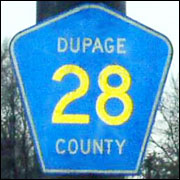 Highway 28 in DuPage County, Illinois
Highway 28 in DuPage County, IllinoisDuPage County Map Within DuPage County: Argonne National Lab Fermi National Accelerator Lab | ||||||||||||
| 138) |
.jpg) King's Highway 28
King's Highway 28in Ontario, Canada (1928-present) Southern terminus: Hwy 2 junction in Port Hope Eastern terminus: Hwy 41 junction in Denbigh Length: 208.2 km (1997). | ||||||||||||
|
28 in Sports and Games
| |||||||||||||
| 139) |
Baseball's
28th All-Star Game was played at Municipal Stadium, Kansas City, Missouri, on July 11, 1960. The day was hot— the temperature broke 100o— and so were the National League bats. Willie Mays paced the attack with a leadoff triple, and later doubled & singled. Ernie Banks homered & doubled. Del Crandall homered & singled. Joe Adcock double & singled. The National League won 5-3, with Bob Friend as the winning pitcher, throwing a one-hit shutout in 3 innings. Al Kaline homered in two runs in the 8th for the American League. Total Baseball, 4th Ed., Viking, NY (1995), p. 262 (The Baseball Encyclopedia, 8th Edition, Macmillan, NY, 1990, p. 2766) | ||||||||||||
| 140) |
Baseball's
28th World Series (1931): St. Louis Cardinals defeats Philadelphia Athletics 4-3 Cardinals' Pepper Martin bats 0.500 (12 for 24), including 4 doubles & homer, 5 runs, 5 rbi, & 5 stolen bases. Bill Hallahan wins two games with 0.49 ERA, He also saved the 7th game, retiring last batter in relief. (The Baseball Encyclopedia, 8th Edition, Macmillan, NY, 1990, p. 2656) | ||||||||||||
| 141) |
Harry Davis is
ranked in 5th place with 28 triples in a single season (1897). (The Baseball Encyclopedia, 8th Edition, Macmillan, NY, 1990, p. 33) | ||||||||||||
| 142) |
Baseball pitchers Still Bill Hill (1896) and
Duke Esper (1893) are tied for 7th place for losses with 28 in a single season. (The Baseball Encyclopedia, 8th Edition, Macmillan, NY, 1990, p. 35) | ||||||||||||
| 143) |
National League Home Run Leaders in Baseball: 1933 Chuck Klein, Philadelphia Phillies, 28 Homers 1939 Johnny Mize, St. Louis Cardinals, 28 Homers 1945 Tommy Holmes, Boston Red Sox, 28 Homers World Almanac & Book of Facts 2005, p. 883 | ||||||||||||
| 144) |
National League Pitching Victory Leaders in Baseball: 1902 Jack Chesbro, Pittsburgh, 28 Wins 1911 Grover Alexander, Chicago, 28 Wins 1924 Dazzy Vance, Brooklyn, 28 Wins 1935 Dizzy Dean, St. Louis, 28 Wins 1952 Robin Roberts, Philadephia, 28 Wins World Almanac & Book of Facts 2005, p. 897 | ||||||||||||
| 145) |
American League Pitching Victory Leaders in Baseball: 1903 Cy Young, Boston, 28 Wins 1911 Jack Coombs, Philadelphia, 28 Wins 1914 Walter Johnson, Washington, 28 Wins 1917 Eddie Cicotte, Chicago, 28 Wins 1930 Lefty Grove, Philadephia, 28 Wins World Almanac & Book of Facts 2005, p. 897 | ||||||||||||
| 146) |
 Joe DiMaggio's 28th consecutive hit-game
Joe DiMaggio's 28th consecutive hit-gameoccurred on June 3, 1941 when he got a hit off Dizzy Trout of the Detroit Tigers. (56-game hitting streak) | ||||||||||||
| 147) |
Rickey Henderson had his 28th stolen base (3rd base) against John Denny of the Cleveland Indians on May 6, 1982 when he set the season stolen base record of 130 in 1982. | ||||||||||||
| 148) |
28 runs were scored by Ty Cobb, 1917 Tigers, during his 35 games hitting streak, going 64-for-138 (.457). 28 runs were scored by Heinie Manush, 1933 Senators, during his 33 games hitting streak going 50-for-140 (.357). (Baseball Hitting Streaks) | ||||||||||||
| 149) |
 Boston Red Sox catcher
Boston Red Sox catcherDoug Mirabelli (uniform #28) hits a grand slam homer in the 6th inning on July 3, 2004 off Atlanta Braves John Thomson with Curt Schilling winning 6-1. | ||||||||||||
| 150) |
NFL Super Bowl XXVIII (1994):
Dallas Cowboys defeats Buffalo Bills 30-13 at Georgia Dome, Atlanta, Georgia January 30, 1994; Attendance: 72,817 World Almanac & Book of Facts 2005, p. 921 | ||||||||||||
| 151) |
NFL Super Bowl Single-Game Statistical Leaders—
Super Bowl XXXVI (2002): Kurt Warner completes 28 passes of 44 attempted for 365 yards and one touchdown in a losing cause as New England Patriots defeats St. Louis Rams 20-17 at New Orleans' Louisiana Superdome, on February 3, 2002; Attendance: 72,922. New England's Quarterback Tom Brady won the MVP completing 16 passes of 27 attempted for 145 yards & one touchdown. World Almanac & Book of Facts 2005, p. 921 | ||||||||||||
| 152) |
28 Touchdowns in a season thrown by NFL Passing Leaders: 1978 Terry Bradshaw, Pittsburgh Steelers, 207/368, 2915 yards, 28 TD 1984 Joe Montana, San Francisco 49ers, 279/432, 3630 yards, 28 TD 1988 Boomer Esiason, Cincinnati Bengals, 223/388, 3572 yards, 28 TD 1989 Boomer Esiason, Cincinnati Bengals, 258/455, 3525 yards, 28 TD World Almanac & Book of Facts 2005, pp. 921-923 | ||||||||||||
| 153) |
1992 AFC Wild Card Football Game — Houston Oilers vs. Buffalo Bills: Houston Oiler's quarterback Warren Moon throws four touchdown passes in the first half giving Houston a commanding 28-3 lead at the break. Houston increases their lead 35-3 with 13:19 left in the third quarter. Buffalo's Frank Reich throws three touchdown passes as the Bills scored 28 points in less than seven minutes, cutting Houston's lead to 35-31. With 3:08 left in the game Reich throws a touchdown pass to André Reed giving Buffalo its first lead of the game 38-35. Houston ties the game with a field goal with 12 seconds left sending the game into overtime. Steve Christie's 32-yard field goal gives Buffalo a dramatic 41-38 victory. | ||||||||||||
| 154) |
Most rebounds in one half of a NBA game is 28 by Wilt Chamberlain, Philadelphia vs. Syracuse, February 6, 1960 The Official NBA Encyclopedia, 3rd Ed. (2000), p. 862 | ||||||||||||
| 155) |
Bob Cousy, Guy Rodgers, and
John Stockton are tied for 3rd place for most assists in a NBA game with 28 (1st: Scott Skiles 30, 2nd: Kevin Porter 29) The Official NBA Encyclopedia, 3rd Ed. (2000), p. 862 | ||||||||||||
| 156) |
Most consecutive games, fewer than 100 points allowed in a NBA season is 28 by the Fort Wayne Pistons from October 30 to December 30, 1954 The Official NBA Encyclopedia, 3rd Ed. (2000), p. 867 | ||||||||||||
| 157) |
Most field goals in a 2-game NBA Playoff Series is 28 by Bob McAdoo, New York vs. Cleveland, 1978 The Official NBA Encyclopedia, 3rd Ed. (2000), p. 870 | ||||||||||||
| 158) |
Most 3-point field goals made in a 7-game NBA Playoff Series is 28 by Dennis Scott, Orlando vs. Indiana, 1995 The Official NBA Encyclopedia, 3rd Ed. (2000), p. 870 | ||||||||||||
| 159) |
Most steals in a 7-game NBA Playoff Series is 28 by John Stockton, Utah vs. L.A. Lakers, 1988 The Official NBA Encyclopedia, 3rd Ed. (2000), p. 871 | ||||||||||||
| 160) |
28th Wimbledon Mens Tennis: Laurie Doherty beats Frank Riseley (6-1, 7-5, 8-6) in 1904. | ||||||||||||
| 161) |
28th Wimbledon Womens Tennis: Dorothea Douglass Chambers beats Dora Boothby (6-0, 6-0) on July 7, 1911. | ||||||||||||
| 162) |
28th Kentucky Derby
was won by Alan-a-Dale
in 2:08.75 with Jockey Jimmy Winkfield aboard (May 3, 1902). | ||||||||||||
| 163) |
28th Preakness Stakes
was won by Flocarline in 1:44.8 with Jockey W. Gannon aboard (May 30, 1903). | ||||||||||||
| 164) |
28th Belmont Stakes
was won by Henry of Navarre in 1:56 with Jockey Willie Simms aboard (June 19, 1894). | ||||||||||||
| 165) |
28th U.S. Golf Open:
Cyril Walker shoots a 297 at Oakland Hills Country Club, Michigan (June 6, 1924) | ||||||||||||
| 166) |
Olympics Gold in Men's 10,000-Meter Run: 1956 Vladimir Kuts, USSR, 28m, 45.6s 1960 Pyotr Bolotnikov, USSR, 28m, 32.2s 1960 Billy Mills, USA, 28m, 24.4s World Almanac & Book of Facts 2005, p. 864 | ||||||||||||
| 167) |
Olympics Gold in Men's Long Jump: 1980 Lutz Dombrowski, E. Germany, 28ft 0.25 in. 1984 Carl Lewis, USA, 28ft 0.25 in. 1988 Carl Lewis, USA, 28ft 7.5 in. 1992 Carl Lewis, USA, 28ft 5.5 in. 2000 Ivan Pedroso, Cuba, 28ft 0.75 in. 2004 Dwight Phillips, USA, 28ft 2.25 in. World Almanac & Book of Facts 2005, p. 866 | ||||||||||||
| 168) |
Winter Olympics Gold in Women's Cross-Country 10 Kilometers Skiing: 2002 Bente Skar, Norway, 28:05.6 World Almanac & Book of Facts 2005, p. 875 | ||||||||||||
| 169) |
Interim Greek Olympics Gold in Men's 1500-Meter Freestyle Swimming (1906) was won by Henry Taylor, Great Britain, 28m 28s. | ||||||||||||
| 170) |
British game of cricket: The cricket wicket is made of three wooden stakes each 28 inches high and 9 inches wide stuck into the ground. | ||||||||||||
| 171) |
 28 tiles in a game of Dominoes:
28 tiles in a game of Dominoes:The rectangular tiles are marked with all possible combinations of numbers that can be rolled with two dice. There are 21 different combinations. But the number zero is always added to the set, by way of "blanks", adding 7 more bones, as the pieces are called. The widely used 6-6 domino set contains 28 pieces. Sets that run up to 12-12, containing 91 pieces but rarely used. History: 1120 A.D. | ||||||||||||
| 172) |
Parker Brothers's
Monopoly board game consists of 40 squares with 28 properties for sale. In the U.S. version, the properties are named after locations in Atlantic City, NJ. | ||||||||||||
|
28 in Postage Stamps, Coins, & Collectibles
| |||||||||||||
| 173) | Postage Stamps with Denominations of 28 (Scott Catalogue # cited) Note: Stamps were scanned & resized in same proportion as originals. Some stamps were retouched in Adobe Photoshop for centering or perforations.
| ||||||||||||
| 174) |
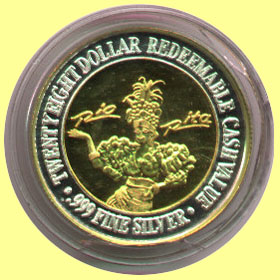 Nevada Silver Gaming Tokens
Nevada Silver Gaming Tokens$28 piece: Rio Rita in costume Other denominations in 0.999 silver: $7, $10, $20, $40, $200 | ||||||||||||
| 175) |
There are 200 cards in
Wings: Friend or Foe Card #28 is "F6F Hellcat", U.S. Navy fighter (Topps 1952) | ||||||||||||
| 176) |
There are 160 cards in
World on Wheels (Topps 1953) Card #28 is "Ford Runabout 1903"
| ||||||||||||
| 177) |
Card #28
of Flags of the World: Bulgaria (Topps 1956)
| ||||||||||||
| 178) |
There are 64 cards in
Firefighters (Bowman, 1952) Card #28 is "1914 Knox Combination"
| ||||||||||||
|
28 in Books & Quotes
| |||||||||||||
| 179) |
"I came to serve you at the age of 28 and now I have not a hair on me that is not white, and my body is infirm and exhausted. All that was left to me and my brothers has been taken away and sold, even the cloak that I wore, without hearing or trial, to my great dishonor." Christopher Columbus (1451-1506), Lettera Rarissima to the Sovereigns, July 7, 1503 (4th Voyage) Bartlett's Familiar Quotations, 17th Edition, Justin Kaplan (Ed.) Little, Brown, & Co., Boston, 2002, p. 140 | ||||||||||||
| 180) |
"Mr Clarke accordingly packed all his furs on 28 horses, and, leaving a clerk and four men to take charge of the post, departed on the 25th of May with the residue of his force." Washington Irving (1783-1859), Astoria, or Anecdotes of an Enterprise Beyond the Rocky Mountains, Chapter LIII, 1836 | ||||||||||||
| 181) |
Twenty-Eight Science Fiction Stories by H. G. Wells was published by Dover Publications, New York, 1952, 915 pp. | ||||||||||||
| 182) |
The 28 Biggest Writing Blunders (and how to avoid them) by William Noble, was published by Writer's Digest Books, Cincinnati, OH, 1992, 120 pp. published by Routledge, London & New York (1994), 205 pp. | ||||||||||||
| 183) |
Twenty-Eight Years in the Life of a University President by George A. Pettitt, with Foreword by Clark Kerr, University of California Press, 1966, 254 pp. It is about Robert Gordon Sproul & the University of California, Berkeley. | ||||||||||||
| 184) |
The Split and the Structure: Twenty-eight Essays by Rudolf Arnheim was published by University of California Press, Berkeley, 1996, 184 pp. | ||||||||||||
| 185) |
Paris: Twenty-eight Drawings by Jean Vigoureux was published by Plantin Press, Los Angeles, 1942, in a limited edition of 300 copies. Introduction by Paul Elliot with 28 plates. | ||||||||||||
| 186) |
Twenty-eight Years in Wall Street by Henry Clews was published by Irving Publishing Co., New York, 1888, 684 pp. | ||||||||||||
| 187) |
Twenty-eight Seconds and After by Elizabeth Strong Worthington, is a tale of the San Francisco earthquake and fire, illustrated by Charles L. Wrenn (1906), 56 pp. | ||||||||||||
| 188) |
Bollingen Series XXVIII is
Paracelsus: Selected Writings Edited by Jolande Jacobi, Translated by Norbert Guterman, Princeton University Press, Princeton, New Jersey, 1951, 362 pp. Philippus Aureolus Paracelsus (1493-1541) | ||||||||||||
| 189) |
.jpg) Volume 28 of
Time Magazine
(1st issue: March 3, 1923)
Volume 28 of
Time Magazine
(1st issue: March 3, 1923)runs from July 6, 1936, XXVIII, No. 1 (Cover: John Llewellyn Lewis) to December 28, 1936, XXVIII, No. 26 (Cover: Japan's Ears & Emperor) Joe DiMaggio on Time cover, Vol. XXVIII, No. 2 (July 13, 1936) Clark Gable on Time cover, Vol. XXVIII, No. 9 (Aug. 31, 1936) Lou Gehrig & Carl Hubbel on Time cover, Vol. XXVIII, No. 14 (Oct. 5, 1936) Marlene Dietrich on Time cover, Vol. XXVIII, No. 22 (Nov. 30, 1936) | ||||||||||||
| 190) |
Volume 28 of
Life Magazine
(1st issue: Nov. 23, 1936) runs from Jan. 2, 1950, XXVIII, No. 1 (Cover: American Life & Times 1900-1950) to June 26, 1950, XXVIII, No. 26 (Cover: Actress Cecile Aubry) Jackie Robinson on Life cover, Vol. XXVIII, No. 19 (May 8, 1950) | ||||||||||||
| 191) |
Volume 28 of the
Dictionary of Literary Biography is titled "Twentieth-Century American-Jewish Fiction Writers" Edited by Daniel Walden, Gale Research, Detroit, 1984 The 51 authors include Nathan Asch, Saul Bellow, E. L. Doctorow, Ben Hecht, Joseph Heller, Erica Jong, Norman Mailer, Bernard Malamud, Tillie Olsen, Cynthia Ozick, Grace Paley, Chaim Potok, Charles Reznikoff, Philip Roth, Delmore Schwartz, Isaac Bashevis Singer, and Lionel Trilling. | ||||||||||||
| 192) |
Volume 28 of
Shakespearean Criticism is the Yearbook 1994 with a selection of the year's most noteworthy studies of William Shakespeare's Plays and Poetry. Gale Research Inc., Detroit, MI, 1996. There are 42 essays in Volume 28: Comedies (11), Histories (10), Tragedies (12), Romances & Poems (9). Mark Thornton Burnett, "The 'Heart of My Mystery': Hamlet and Secrets" (pp. 232-242) William Kerrigan, "The Last Mystery" [Hamlet graveyard scene] (pp. 280-289) John Kerrigan, "Between Michelangelo and Petrarch: Shakespeare's Sonnets of Art" (pp.407-414) | ||||||||||||
| 193) |
Volume 28 of
Classical and Medieval Literature Criticism covers the following writers: Apollonius Rhodius (Greek poet & historian), al-Biruni (Arabic scientist), Jean Bodel (French poet & dramatist), and Ossian (Irish bard). Jelena O. Krstovic (Ed.), Gale Research, Farmington Hills, MI, 1999 | ||||||||||||
| 194) |
Volume 28 of
Literary Criticism from 1400 to 1800 covers the following writers: Pierre Corneille, Moliè, Jean Racine, Claude Prosper Jolyot de Crébillon, Alaine-René Leasage, and French Drama in the Age of Louis XIV. James E. Person, Jr. (Ed.), Gale Research Inc., Detroit, MI, 1995 | ||||||||||||
| 195) |
Volume 28 of
Nineteenth-Century Literary Criticism covers the following topics: The American Frontier in Literature, English Decadent Literature of the 1890s, English Romantic Poetry, The Gothic Novel, and Russian Nihilism (Turgenev & Dostoevsky) Laurie Sherman (Ed.), Gale Research Inc., Detroit, MI, 1990 | ||||||||||||
| 196) |
Volume 28 of
Twentieth-Century Literary Criticism covers 15 writers including: William Rose Bené, F. Scott Fitzgerald, Muhammad Iqbal, John Muir, Gertrude Stein, Leo Tolstoy, & Wen I-to. Dennis Poupard (Ed.), Gale Research Co., Detroit, MI, 1988 | ||||||||||||
| 197) |
Volume 28 of
Contemporary Literary Criticism covers 59 writers including: Bruce Chatwin, Padraic Colum, Peter De Vries, William Dickey, Umberto Eco, William Faulkner, Maxine Kumin, John le Carré Elmore Leonard, Denise Levertov, Mina Loy, Norman Mailer, Pablo Neruda, Cynthia Ozick, Paul Theroux, Anne Tyler, Charles Wright, & James Wright. Jean C. Stine (Ed.), Gale Research Co., Detroit, 1984 | ||||||||||||
| 198) |
Mind is A Quarterly Review of Psychology and Philosophy, published by Macmillan & Co., London Editor: Professor G. F. Stout Volume 28 of Mind (No. 109-112, Jan.-Oct. 1919) Interesting articles in Volume LXXX include: A. S. Pringle-Pattison, "The Idea of God: A Reply to Some Criticisms", Vol. XXVIII, 1-18 (No. 109, Jan. 1919) S. Radhakrishnan, "Bergson and Absolute Idealism", Vol. XXVIII, 41-53 (Jan. 1919); 275-296 (July 1919) A. E. Taylor, Review of W. R. Inge's Philosophy of Plotinus, Vol. XXVIII, 238-245 (No. 110, April 1919) J. Harward, "Discussion: What Does Bergson Mean by Pure Perception? Vol. XXVIII, 463-470 (No. 112, Oct. 1919) Pure perception is the point at which subject and object unite, whereas originally it was the meeting of subject and subject in the formation of an instantaneous image, it is now their meeting in the contraction of vibrations. In pure perception we are actually place outside ourselves, we touch the reality of object in an immediate intution. | ||||||||||||
| 199) |
Volume 28 of
Modern Language Notes (No. 1-8, Jan.-Dec. 1913), pp. 1-264 Johns Hopkins Press, Baltimore, Maryland Managing Editor: C. Carroll Marden Interesting articles in this volume include: Arthur C. L. Brown, "The Spear of Longinus", Review of Rose J. Peebles's Legend of Longinus Vol. XXVIII, 21-26 (No. 1, January 1913) Charles W. Cobb, "The A Scientific Basis for Metrics", Vol. XXVIII, 142-145 (No. 5, May 1913) Benjamin Ives Gilman, "On a Disputed Terzetto in the Paradiso: XXVII.36-38" XXVIII, 148-149 (No. 5, May 1913) Helen Sard Hughes, "Night in the Poetry of Henry Vaughan", XXVIII, 208-211 (No. 7, November 1913) D. S. Blondheim, Book Review of Irving Babbitt's Masters of Modern French Criticism XXVIII, 193-197 (No. 6, June 1913) | ||||||||||||
| 200) |
The Monist is A Quarterly Magazine Devoted to the Philosophy of Science Chicago, Illinois. Founded 1888 by Edward C. Hegeler Volume 28 of The Monist (No. 1-4, Jan.-Oct. 1918), pp. 1-640 Interesting articles in Volume XXVIII include: Hartley B. Alexander, "Plato's Conception of the Cosmos", Vol. XXVIII, 1-24 (No. 1, Jan. 1918) Harry A. Sayles, "Magic Squares & Cubes with Prime Numbers", Vol. XXVIII, 141-158 (No. 1, Jan. 1918) C. Broad, "Body and Mind", Vol. XXVIII, 234-258 (No. 2, April 1918) Hermann Minkowski, "Time and Space", Vol. XXVIII, 288-302 (No. 2, April 1918) William Benjamin Smith, "Mors Mortis", Vol. XXVIII, 321-351 (No. 3, July 1918) Bertrand Russell, "The Philosophy of Logical Atomism", Vol. XXVIII, 495-527 (No. 4, Oct. 1918) | ||||||||||||
| 201) |
Volume 28 of New Directions in Prose and Poetry (1974) Edited by J. Laughlin, New York, pp. 1-184 Interesting poems & articles in Volume 28 include: Paul West, "Brain Cell 9,999,999,999,999", Vol. 28, 62-68 (Spring 1974) Howdy-do, April 23rd 1616. Don't answer: I never have long, am always on call, like the fire brigade, interrupted or left to my own low-keyed devices... I, Cell 9,999,999,999,999, am the ghost of Hamlet Junior's sixteenth line... The Engrammarian al last! No Folio till 1623? Again the 23! 23x3. Lemmings all amelt. Eureka! Choking. Black. Gray. Whi ... Mine Host, O Mega O William Everson, "Tendril in the Mesh", Vol. 28, 110-122 (Spring 1974) Kore! Daughter of dawn! Persephone! Maiden of twilight! Sucked down into Pluto's unsearchable night for your husband. I see you depart, bearing the pomegranate seed in your groin. In the node of your flesh you drip my flake of bestowal. (Section IV, Stanza 3) | ||||||||||||
| 202) |
Volume 28 of
Paris Review (Summer-Fall 1962), pp. 1-196 Publication Office: 16, rue Vernet, Paris 8o, France Editorial Office: 45-39 171 Place, Flushing 58, New York Editors: George A. Plimpton, Peter Matthiessen, Tobert B. Silvers, Blair Fuller Interesting articles in this volume include: Ezra Pound, "Two Cantos" Vol. XXVIII, 13-17 (Summer-Fall 1962) Time, space, neither life nor death is the answer. (Canto 115) I have brought the great ball of crystal, who can lift it? Can you enter the great acorn of light?... If love be not in the house there is nothing (Canto 116) The Art of Poetry V— Ezra Pound: An Interview by Donald Hall Vol. XXVIII, 22-51 (Summer-Fall 1962) Interviewer: Do you have anything special to say to the young? Pound: To improve their curiosity and not to fake. But that is not enough. The mere registering of bellyache and the mere dumping of the ashcan is not enough. The University of Pennsylvania student Punchbowl used to have as its motto, "Any damn fool can be spontaneous." Jorge Luis Borges, "Funes The Memorious", Vol. XXVIII, 120-127 (Summer-Fall 1962) The Art of Fiction XXVIII— Henry Miller: Interview by George Wickes Vol. XXVIII, 128-159 (Summer-Fall 1962) Interviewer: You speak of "the dictation," of being almost possessed, of having this stuff spilling out of you. How does this process work? Miller: A writer shouldn't think much... I work from some deep down place; and when I write, well, I don't know just exactly what's going to happen... The passages I refer to are tumultuous, the words fall over one another... If, say, a Zen artist is going to do something, he's had a long preparation of discipline and meditation, deep quiet thought about it, and then no thought, silence, emptiness, and so on— it might be for months, it might be for years. Then, when he begins, it's like lightning, just what he wants— it's perfect. Well, this is the way I think all art should be done. | ||||||||||||
| 203) |
Partisan Review was published bi-monthly by the American Committee for Cultural Freedom, Inc. at 22 East, 17th Street, New York Volume 28 of Partisan Review (No. 1-6, Jan-Aug 1961), 1-732 Editors: William Phillips and Philip Rahv Interesting articles in Volume XXVIII include: Lionel Trilling, "On the Modern Element in Modern Literature", Vol. XXVIII, 9-35 (No. 1, Jan-Feb 1961) Frank Kermode, "Poet and Dancer Before Diaghilev", Vol. XXVIII, 48-75 (No. 1, Jan-Feb 1961) W. S. Merwin, "Route with No Number", Vol. XXVIII, 76-78 (No. 1, Jan-Feb 1961) Mother, Father, Luke and John, My line, my sign, my love, Think of the cards that were held out to me And I had to choose this one. Mary McCarthy, "Characters in Fiction", Vol. XXVIII, 171-191 (No. 2, March-April 1961) "The wind blows up the tent like a balloon." Boris Pasternak, "Without Love: A Chapter from a Novel", Vol. XXVIII, 363-371 (No. 3-4, May-June 1961) Anne Sexton, "Six Poems", Vol. XXVIII, 605-611 (No. 5-6, July-Aug 1961) Robert Greer Cohn, "Without Love: A Chapter from a Novel", Vol. XXVIII, 633-645 (No. 5-6, July-Aug 1961) | ||||||||||||
| 204) |
Poetry: A Magazine of Verse was founded in 1912. Volume 28 of Poetry (No. I-VI, April-September, 1926) Editor: Harriet Monroe; 232 East Erie Street, Chicago Interesting poems & articles in Volume XXVIII include: Vachel Lindsay, "The Forest Ranger's Honeymoon", Vol. XXVIII, 1-8 (April 1926) "But all I can bring home / Is one more song." Archibald MacLeish, "Ars Poetica", Vol. XXVIII, 126-127 (June 1926) "A poem should not mean, / But be." Dorothy Hawkins, "Epigram", Vol. XXVIII, 135 (June 1926) You speak my language— And, because you do, You do not talk, And I hear you. John Dos Passos, "Crimson Tent", Vol. XXVIII, 188-189 (July 1926) "The wind blows up the tent like a balloon." Harriet Monroe, "Mephistophles and the Poet", Vol. XXVIII, 210-215 (July 1926) "Mephistopheles, the popular-minded editor, must do everything he can to supply the demand of his vast public." | ||||||||||||
| 205) |
Sequoia was Stanford Literary Magazine (Poetry, Fiction, Essays, Reviews) published three times a year. Volume 28 of Sequoia (No. I-3, Winter, Spring, Autumn 1984) Editor: Gordon Harvey Interesting poems & articles in Volume XXVIII include: Helen Pinkerton, "Poems on Works of Art", Vol. XXVIII, No. 1, 29-31 (Winter 1984) Mark Hillringhouse, "An Interview with W. S. Merwin", Vol. XXVIII, No. 1, 38-45 (Winter 1984) Interview at Merwin's New York apartment on Dec. 7th & 14th, 1982) MH: Pinsky says that your poetic process is romantic, your way of getting there dreamlike, involving silence, extreme romanticism, pursuit of darkness, pursuit of silence. WSM: I don't know what the definition of romanticism is on which that's based. Silence, I think, underlies every real perception. It involves articulation. And I don't think I pursue darkness; darkness in the 20th century involves only keeping your eyes open. I really think poetry is involved with being awake. I don't think that contradicts what I take as a fact, that what we're awake in is a dream. So, if you're talking about poetry having to deal with dreams in that sense I absolutely agree. Kenneth Fields, "The Book of Love", "Not Enough", "from Classic Rough News" Vol. XXVIII, No. 2, 47-49 (Spring 1984) Perhaps it was that book, the golden light Floating forever in a darkening wind This way and that, like pages in the air Blown here and there, like leaves— we wanted this Eternally. god, we were here already! We were in each other's arms, and will always be, As if bound in a book, like the one we read Fitfully, all that morning, through this long night— (Lines 1-8 of 27-lines poem "The Book of Love: Francesca da Rimini") Andrew Hudgins, "An Interview with Donald Justice", Vol. XXVIII, No. 3, 18-28 (Autumn 1984) Interview at Stanford Terrace Hotel on March 8th, 1984) AH: You have a selection of interviews and critical prose coming out from Michigan. DJ: In the Poets on Poetry series. The title is Platonic Scripts. I said once that when I'm working on a poem I usually think of it as if the exact and ideal poem were written down somewhere— had a sort of platonic pre-existence— and all I was doing was trying to transcribe that, get every word right. That's not very well said, but it's one way of thinking of the ideal nature of art. I do really think of it like that; I don't see why everybody doesn't, everybody who's not satisfied with journalism. | ||||||||||||
| 206) |
The Sewanee Review is America's oldest literary quarterly Volume 28 of Sewanee Review (No. 1-4, Jan.-Oct. 1920), pp. 1-612 Edited by George Herbert Clarke Interesting articles in Volume XXVIII include: William H. Scheifley, "A Mystic Singer of Jeanne D'Arc", Vol. XXVIII, 31-36 (No. 1, Jan-March, 1920) On Charles Péguy who died at Marne. Winthrop Dudley Sheldon, "Why Education Failed to Educate Henry Adams", Vol. XXVIII, 54-65 (No. 1, Jan-March, 1920) "On an old Italian gateway there is this inscription, which should be above the door of every schoolroom: "So enter here, that daily thou mayest become more learned and more thoughtful; so depart, that daily thou mayest become more useful to thy country and to mankind." Garland Greever, "Romanticism as a Philosophy of Life", Vol. XXVIII, 101-105 (No. 1, Jan-March, 1920) Robert Morris Ogden, "Is Immortality Plausible?", Vol. XXVIII, 129-138 (No. 2, Apr-June, 1920) Jay William Hudson, "The Religion of Emerson", Vol. XXVIII, 203-212 (No. 2, Apr-June, 1920) "My best thought of Emerson pictures him as a man with the heart of a child" Chilton Latham Powell, "Education and Religion", Vol. XXVIII, 558-572 (No. 4, Oct-Dec, 1920) "in order to be great one must first be good, that to be good as well as strong for service." Arthur L. Keith, "The Spirit of Horace", Vol. XXVIII, 573-596 (No. 4, Oct-Dec, 1920) "Horace is a priest of the Muses singing to youth songs never heard before. His was an exalted mission." | ||||||||||||
| 207) |
Volume 28 of
Film Quarterly (No. I-4, Fall 1974-Summer 1975) Published by the University of California Press, Berkeley, CA 94720 Editor: Ernest Callenbach Interesting articles in Volume XXVIII include: William Cadbury, "Theme, Felt Life, and the Last Minute Rescue in Griffith After Intolerance Vol. XXVIII, 39-49 (No. 1, Fall 1974) Claudia Gorbman, "Music as Salvation: Notes on Fellini and Rota" Vol. XXVIII, 17-25 (No. 2, Winter 1974-75) Michael Dempsey, "John Ford: A Reassessment" Vol. XXVIII, 2-15 (No. 4, Summer 1975) | ||||||||||||
| 208) |
Volume 28 of
Sight and Sound (The International Film Quarterly) (No. I-4, Winter 1958-59-Autumn 1960) Published by the British Film Institute, London Editor: Penelope Houston Interesting articles in Volume XXVIII include: Louise Brooke, "Gish and Garbo: the executive war on stars" Vol. 28, 12-17 (No. 1, Winter 1958-59) Philip Oakes, "James Cagney" Vol. 28, 24-25 (No. 1, Winter 1958-59) "Jean Renoir and Roberto Rossellini" interviewed by André Bazin Vol. 28, 26-30 (No. 1, Winter 1958-59) Bertolt Brecht, "An Address to Danish Worker Actors" Vol. 28, 131-132 (No. 3-4, Summer-Autumn 1959) "Visconti" interviewed by Jacques Doniol-Valcroze & Jean Domarchi Vol. 28, 144-147, 191 (No. 3-4, Summer-Autumn 1959) | ||||||||||||
|
28 in Art, Music, Film
| |||||||||||||
| 209) |
 Woodblock Print 28
Woodblock Print 28of 36 Views of Fuji (1856-1858) by Japanese painter & printmaker Katsushika Hokusai (1760-1849) is titled "Tago Bay near Ejiri on the Tokaido" showing boats in waves with Mt. Fuji in the background. 24 Views of Mount Fuji | ||||||||||||
| 210) |
 Surugadai in the Eastern Capital
Surugadai in the Eastern Capitalis View 28 in 36 Views of Mount Fuji (1852), a set of woodblock prints by Utagawa Hiroshige (1797-1858). | ||||||||||||
| 211) |
 Lake Suwa in Shinano Province
Lake Suwa in Shinano Provinceis View 28 in 36 Views of Mount Fuji (1858), a second set of woodblock prints by Utagawa Hiroshige (1797-1858). | ||||||||||||
| 212) |
 Station 28: Fukuroi is one of the
53 Stations of the Tokaido,
Station 28: Fukuroi is one of the
53 Stations of the Tokaido,a set of woodblock prints by Utagawa Hiroshige (1797-1858). The original prints were completed in 1834, but Hiroshige returned to the subject again and again. There are actually 55 prints in the series. It includes not only the 53 way stations on the road from Tokyo to Kyoto, but also the starting point at the Nihon-bashi (Japan bridge) in central Tokyo, and the ending at Kyoto. (Map of 53 Stations) | ||||||||||||
| 213) |
 Woodblock Print 28
Woodblock Print 28of 100 Views of Edo (1856-1858) by Japanese painter & printmaker Ando Hiroshige (1797-1858) is titled "Goten Hill at Shinagawa" showing people hiking up a hill with trees in the horizon. | ||||||||||||
| 214) |
 28"x28" is the dimension of
28"x28" is the dimension ofHomage to the Square (1955) by Josef Albers (1888-1976) Study for Homage to the Square (1960) Study for Homage to the Square (1964) National Gallery of Art; 5 Posters of 28"x28" Albers' Squares | ||||||||||||
| 215) |
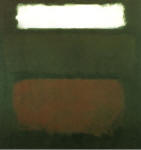 Oil Painting #28
Oil Painting #28by Mark Rothko (1903-1970) is Untitled (1962). National Gallery of Art; PBS Newshour | ||||||||||||
| 216) |
Painting 28 by
Quentin Smith is also titled "Sitting on the Edge of Being" (March-Nov. 2002) | ||||||||||||
| 217) |
Krishna Print #28 shows "Lord Krishna lifting Govardhan Hill with the little finger of His left hand." from the Krishna Darshan Art Gallery featuring 122 paintings of Lord Krishna. | ||||||||||||
| 218) |
Johann Sebastian Bach's
Church Cantata #28 was performed on Dec. 30, 1725. (Gottlob! nun geht das Jahr zu Ende) [New Grove Dictionary of Music & Musicians, Vol. 1 (1980), p. 819] | ||||||||||||
| 219) |
Joseph Haydn's
Symphony #28 in A Major (1765), 2 oboes, 2 horns, & strings [New Grove Dictionary of Music & Musicians, Vol. 8 (1980), p. 371] | ||||||||||||
| 220) |
George Frideric Handel's
Messiah XXVIII is the Chorus "He trusted in God" (1741) Recording: Leonard Bernstein, New York Philharmonic & Westminster Choir | ||||||||||||
| 221) |
Wolfgang Amadeus Mozart's
Symphony #28 in C Major, K200 (Salzburg, Nov. 17, 1774) 2 oboes, 2 horns, 2 trumpets, timpani, & strings (4 movements) [New Grove Dictionary of Music & Musicians, Vol. 12 (1980), p. 736] | ||||||||||||
| 222) |
Beethoven's
Opus #28 is Piano Sonata No. 15 in D major "Pastoral" (1801) It was dedicated to Joseph von Sonnenfals [New Grove Dictionary of Music & Musicians, Vol. 2 (1980), p. 399] | ||||||||||||
| 223) |
Beethoven's
Piano Sonata #28 in A (1816) was dedicated to Baroness Dorothea Ertmann [New Grove Dictionary of Music & Musicians, Vol. 2 (1980), p. 399] | ||||||||||||
| 224) |
Felix Mendelssohn's Opus #28
is Piano Solo Fantasia in F Sharp minor, "Sonate écossaise" (January 29, 1833). [New Grove Dictionary of Music & Musicians, Vol. 12 (1980), p. 153] (MP3 Recording: Serg van Gennip) | ||||||||||||
| 225) |
Frederic Chopin's
Opus #28 is Piano Solo "24 Preludes" (1836-1839) [New Grove Dictionary of Music & Musicians, Vol. 4 (1980), p. 308] | ||||||||||||
| 226) |
Robert Schumann's
Opus #28 is Keyboard for Solo "3 Romances" (composed 1839) [New Grove Dictionary of Music & Musicians, Vol. 16 (1980), p. 861] | ||||||||||||
| 227) |
There are 28 songs in Robert Schumann's
Opus #79 "Lieder-Album für die Jugend" (composed 1849) Song #28 in Mignon (Kennst du das Land), lyrics by Goethe [New Grove Dictionary of Music & Musicians, Vol. 16 (1980), p. 861] | ||||||||||||
| 228) |
Johannes Brahms'
Opus #28
is "4 Duets for Alto & Baritone with Piano in A" (1860-1861) Die Nonne und der Ritter; Vor der Tür; Es rauschet das Wasser; Der Jäger und sein Liebchen [New Grove Dictionary of Music & Musicians, Vol. 3 (1980), p. 177] MP3 Recording: Masaru Suzuki (27 September 2003 at Tsukuba Ars Hall) | ||||||||||||
| 229) |
Pyotr Il'yich Tchaikovsky's
Opus #28 is "Six Songs" (April 23, 1875) I shall never tell; Why did I dream of you; He loved me so much; No response, or word, or greeting; The corals; The fearful minute [New Grove Dictionary of Music & Musicians, Vol. 18 (1980), p. 633] | ||||||||||||
| 230) |
Sergei Prokofiev's
Opus #28 is Piano Sonata #3 (from old notebooks) (1917) [New Grove Dictionary of Music & Musicians, Vol. 15 (1980), p. 300] | ||||||||||||
| 231) |
Sergei Rachmaninoff's
Opus #28 is Piano Sonata #1 in D minor (1907) [New Grove Dictionary of Music & Musicians, Vol. 15 (1980), p. 557] | ||||||||||||
| 232) |
Elvis Presley's
Don't Be Cruel made it to #1 on all three main Billboard singles charts (July 13, 1956): 11 weeks at #1 on the pop chart with a total of 28 weeks on the chart. The B-side was Hound Dog. | ||||||||||||
| 233) |
The Great Twenty-Eight by Chuck Berry is an Audio CD (1990) with original release in 1982 (MCA). The 28 tracks include: Maybelline, Thirty Days, Roll Over Beethoven, and Johnny B. Goode. | ||||||||||||
| 234) |
28th Street
is a British strings & vocal music group with an album In Love / Want My Loving (White Label) | ||||||||||||
| 235) |
Twenty Eight is a song by Tim Rogers, lead singer of the Australian rock group You Am I . It is from his first solo album What Rhymes with Cars and Girls (Winter 1998) A heaven's to Betsy now we're 28 and what is there to do? We hardly even talk no more but to you I'll be true Tell me that you feel the same even though I knew Everything that you say right before it came from you Art house movies and flat renovations Newspaper politic and dinner reservations, oh And Monday's a wine appreciation course Talk about te drugs that you just wont touch no more What a breeze just help me off my knees do do do do Now we're 28 and what is there to do? We hardly even talk no more but to you I'll be true To you I'll be true To you I'll be true To you I'll be true (Lines 1-10, 20-25; Complete Lyrics) | ||||||||||||
| 236) |
Twenty-Eight Teeth is a LP album from the punk rock group Buck-O-Nine (TVT Records, April 1997). It contains the song: "Twenty-Eight Teeth" you ever been so bored that you start counting all your teeth as you squirm around and fidget in you cluttered, lousy seat you ever been so tired that your spirit starts to sigh and your working everyday just to make ends meet what keeps me hangin' on? you ever wake up in a hotel room but can't remember the city or state you look around, you roam around but your mind just can't relate you ever been so lost that a map won't do you no good as you drive around in circles in a place or town or some kind of neighborhood you ever been so desperate but for what you just don't know you see a thousand faces and you want to remember them all | ||||||||||||
| 237) |
The Unbeaten 28
(1980) is a Hong Kong Kung-fu film directed by Joseph Kuo. Meng Fei fights stone men to become a Kung-fu master. | ||||||||||||
| 238) |
 28 Days is a 104-minutes color film (2000) directed by Betty Thomas.
28 Days is a 104-minutes color film (2000) directed by Betty Thomas.Cast: Sandra Bullock, Viggo Nortensen, Dominic West, Diane Ladd, Elizabeth Perkins, and Steve Buscemi. Drunken N.Y. writer with an equally boozy boyfriend checks into rehab after an alcohol induced accident. She gradually conforms to the program after the institution's seen-it-all patients swing their hatchets at the chip on her shoulder. — Leonard Maltin (Ed.), Movie & Video Guide (2002), Signet Book, New York, 2001, p. 1450 (Review) | ||||||||||||
| 239) |
 28 Days Later is a 113-minutes color film (2002)
28 Days Later is a 113-minutes color film (2002)directed by Danny Boyle. Cast: Alex Palmer, Bindu De Stoppani, Jukka Hiltunen, David Schneider, Cillian Murphy. This Sci-Fi Thriller is about four weeks after a mysterious, incurable virus spreads throughout the U.K., and a handful of survivors try to find sanctuary. (Review) | ||||||||||||
| 240) |
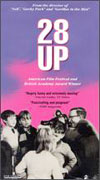 28 Up is a 133-minutes color/B&W British film (1985) directed by Michael Apted.
28 Up is a 133-minutes color/B&W British film (1985) directed by Michael Apted.Unique documentary in which Apted interviews a diverse group of individuals at age 7, 14, 21, 28. A one-of-a-kind portrayal of dreams, aspirations, and realities; fascinating to see the subjects literally age before your eyes. Originally made for TV in separate installments. This film was followed by 35 Up. — Leonard Maltin (Ed.), Movie & Video Guide (2002), Signet Book, New York, 2001, p. 1450 (Review; NY Times) | ||||||||||||
| 241) |
28th Motion Picture Academy Awards (Oscars) in 1955: Best Picture: Marty, MGM Best Director: Delbert Mann, Marty Best Actor: Ernest Borgnine, Marty Best Actress: Anna Magnani, The Rose Tattoo Supporting Actor: Jack Lemmon, Mister Roberts Supporting Actress: Jo Van Fleet, East of Eden The World Almanac and Book of Facts (2005), p. 328 | ||||||||||||
|
28th Ranking in Lists
| |||||||||||||
| 242) |
98.5WNCX, Cleveland's Classic Rock radio station
has ranked the Top 98 LP albums Rolling Stones' Let It Bleed (1969) was selected as the 28th Greatest LP. (#1. Pink Floyd, "Dark Side of the Moon", #2. "Led Zepplin 4", #3. Beatles, "White Album") | ||||||||||||
| 243) |
Rolling Stone Magazine's poll of the 500 Greatest Songs of All Time has named Otis Redding's Sittin' on the Dock of the Bay (1968) as the 28th Greatest Song. (#1. Bob Dylan "Like a Rolling Stone", #2. Rolling Stones "Satisfaction", #3. John Lennon "Imagine") | ||||||||||||
| 244) |
Francis Ford Coppola's Apocalyse Now (1979) was selected as the 28th best film in AFI's 100 Years... 100 Movies (1998). Based on Joseph Conrad's Heart of Darkness, this Vietnam war film starred Marlon Brando, Martin Sheen, Robert Duvall, Dennis Hopper, and Harrison Ford. | ||||||||||||
| 245) |
The Shop Around the Corner (1940)
was selected as the 28th best love stories film in AFI's 100 Years... 100 Passions (2002). Directed by Ernst Lubitsch, the film starred James Stewart & Margaret Sullivan. | ||||||||||||
| 246) |
Fatal Attraction (1987)
was selected as the 28th best thriller film in AFI's 100 Years... 100 Thrills (2001). Directed by Adrian Lyne, the film starred Michael Douglas & Glenn Close. | ||||||||||||
| 247) |
Ghostbusters (1984)
was selected as the 28th funniest film in AFI's 100 Years... 100 Laughs (2000). Directed by Ivan Reitman, the film starred Bill Murray, Dan Aykroyd, & Sigourney Weaver. | ||||||||||||
| 248) |
"Some Enchanted Evening" from the film
South Pacific (1958) was selected as the 28th best song in AFI 100 Years... 100 Songs (2004). Directed by Joshua Logan; Music & Lyrics: Richard Rodgers & Oscar Hammerstein II. The film starred Rossano Brazzi (voiced by Giorgio Tozzi) & Mitzi Gaynor. | ||||||||||||
| 249) |
In the KDFC 2004 Top #100 Classical All-Star Music Poll, Handel's Largo was selected as the 28th musical piece (Aired January, 2005) (Musical Piece #27: Mozart, Magic Flute; Piece #29: Mendelssohn, Violin Concerto) (Top pieces: Beethoven's Symphony #9, Rachmaninoff's Piano Concerto #2, Bach's Brandenburg Concertos; Top composers: Beethoven, Mozart, Bach; Top performers: Yo Yo Ma, Itzhak Perlman, Joshua Bell) | ||||||||||||
| 250) |
In the book Sporting News Selects
Baseball's 100 Greatest Players (1998), Mike Schmidt of the Philadelphia Phillies was ranked the 28th best baseball player of all time. (#1 Babe Ruth; #2 Willie Mays; #3 Ty Cobb; #4 Walter Johnson) | ||||||||||||
| 251) |
In the book Sporting News Selects
Football's 100 Greatest Players (1999), Forrest Gregg of the Green Bay Packers was ranked the 28th best football player of all time. (#1 Jim Brown; #2 Jerry Rice; #3 Joe Montana; #4 Lawrence Taylor) | ||||||||||||
| 252) |
In the book
1,000 Years, 1,000 People: Ranking the Men and Women Who Shaped the Millennium by Agnes Hooper Gottlieb, Henry Gottlieb, Barbar Bowers, Brent Bowers (1998), Thomas Alva Edison was ranked the 28th most influential person of the millennium 1001-2000. (#1 Johannes Gutenberg; #2 Columbus; #3 Martin Luther; #4 Galileo) | ||||||||||||
| 253) |
Houston Public Library
was ranked as the 28th largest library (5,187,973 volumes) in a listing of "The 100 Largest Libraries in the United States" (1999). (#1 Library of Congress; #2 Harvard University; #3 New York Public Library; #4 Yale University) 2003 Listing: #28 Ohio State University (5,674,784 volumes) (#1 Library of Congress; #2 Harvard University; #3 Boston Public Library; #4 Chicago Public Library) | ||||||||||||
| 254) |
In Martin Seymour-Smith's book
The 100 Most Influential Books Ever Written: The History of Thought from Ancient Times to Today (1998), Moses de Leon's The Kabbalah (12th century) was listed as the 28th book in chronological order among the 100 most influential books in the history of thought. | ||||||||||||
| 255) |
In Henry Miller's
The Books in My Life (1969) Gérard De Nerval's works was listed as the 28th book in author alphabetical order among the 100 most influential books that Henry Miller has read. | ||||||||||||
| 256) |
In
The Internet Top 100 Science Fiction/Fantasy List (July 6, 2003) Fiasco by Stanislaw Lem was ranked as the 28th most popular book. (#1 George R. Martin, A Song of Ice and Fire; #2 J.R.R. Tolkien, Lord of the Rings; #3 Lois M. Bujold, The Vorkosigan Series) | ||||||||||||
| 257) |
Bangkok, Thailand was ranked as the 28th most populous city (7,221,000) in Top 100 Cities of the World— ranked by population. (#1 Tokyo, Japan; #2 Mexico City, Mexico; #3 Mumbai, India; #4 Sáo Paulo, Brazil) | ||||||||||||
| 258) |
Colombia was ranked as the 28th most populous country (40,036,927) in Top 100 Countries of the World— ranked by population. (#1 China; #2 India; #3 United States; #4 Indonesia; #5 Brazil) | ||||||||||||
| 259) |
"Had" was ranked as the 28th most used English word in The First 100 Most Commonly Used English Words from The Reading Teacher's Book of Lists (4th Ed., 2000) by Edward Bernard Fry, Jacqueline E. Kress, & Dona Lee Fountoukidis (#1 the, #2 of, #3 and, #4 a, #5 to, #6 in, #7 is, #8 you, #9 that, #10 it) In a survey of The 500 Most Commonly Used Words in English "had" was ranked as the 28th most commonly used English word. | ||||||||||||
| 260) |
In The Modern Library 100 Best Novels (2003). Board's List 28th best novel: F. Scott Fitzgerald's Tender Is the Night (#1 James Joyce, Ulysses; #2 F. Scott Fitzgerald, The Great Gatsby) Reader's List 28th best novel: John Irving's A Prayer for Owen Meany (#1 Ayn Rand, Atlas Shrugged; #2 Ayn Rand, The Fountainhead) | ||||||||||||
| 261) |
In The Modern Library 100 Best Nonfiction (2003). Board's List 28th best nonfiction: John Rawls's A Theory of Justice (#1 Henry Adams, The Education of Henry Adams; #2 William James, Varieties of Religious Experience) Reader's List 28th best nonfiction: Vladimir Nabokov's Speak, Memory (#1 Ayn Rand, Virtue of Selfishness; #2 L. Ron Hubbard, Dianetics) | ||||||||||||
| 262) |
28th best-loved novel is John Irving's A Prayer for Owen Meany in BBC's Big Read: Top 100 (April 2003). #27 George Eliot's Middlemarch; #29 John Steinbeck's The Grapes Of Wrath (#1 JRR Tolkien, Lord of the Rings; #2 Jane Austen, Pride and Prejudice) | ||||||||||||
| 263) |
28th most popular book downloaded is Steven Levy's Hackers: Heroes of the Computer Revolution in Project Gutenberg's Top 100 (1-22-2005). #27 Dante's The Divine Comedy; #29 Samuel Butler's Erewhon Revisited (#1 Notebooks of Leonardo; #2 Sun Tzu, Art of War; #3 Sir Arthur Conan Doyle, Adventures of Sherlock Holmes; #4 James Joyce, Ulysses) | ||||||||||||
| 264) |
Judith Warner's
Perfect Madness: Motherhood in the Age of Anxiety was the 28th most popular book in Amazon.com's Top 100 Sellers (March 22, 2005) #27 Randy Wayne White, Dead of Night #29 Allison DuBois, Don't Kiss Them Good-bye [#1 J.K. Rowling, Harry Potter and the Half-Blood Prince (Book 6)] | ||||||||||||
| 265) |
Belgium was ranked as the 28th country favored by tourists with 3,163,000 visitors in Tourist Arrivals (#1 France; #2 United States; #3 Spain; #4 Italy; #5 Hungary) George Thomas Kurian, The Illustrated Book of World Rankings, Sharpe Reference, Armonk, NY, 1997, p. 211 | ||||||||||||
| 266) |
Car Talk was ranked as the 28th most popular web site in Web 100: Top 100 by web100.com (#1 CNET; #2 Shutterfly; #3 ESPN.com; #4 National Geographic Online) | ||||||||||||
|
28 in the Bible
| |||||||||||||
| 267) |
28th word of the King James Bible's Old Testament Genesis = And
1: In the beginning God created the heaven and the earth. 2: And the earth was without form, and void; and darkness was upon the face of the deep. And the Spirit of God moved upon the face of the waters. — Genesis I.1-2 (1611) | ||||||||||||
| 268) |
28 occurs in the Bible 5 times and 8 times as part of other numbers: The length of one curtain shall be eight and twenty cubits. — Exodus, 26.2 (1491 B.C.) The length of one curtain was twenty and eight cubits, and the breadth of one curtain four cubits: the curtains were all of one size. — Exodus, 36.9 (1491 B.C.) And the time that Jehu reigned over Israel in Samaria was twenty and eight years.. — II Kings, 10.36 (884 B.C.) And Rehoboam loved Maachah the daughter of Absalom above all his wives and his concubines: (for he took eighteen wives, and threescore concubines; and begat twenty and eight sons, and threescore daughters.) — II. Chronicles, 11.21 (840 B.C.) And of the sons of Bebai; Zechariah the son of Bebai, and with him twenty and eight males. — Ezra, 8.11 (536 B.C.) The Complete Concordance to the Bible (New King James Version) Thomas Nelson Publishers, Nashville, TN (1983) | ||||||||||||
| 269) |
Chapter 28 in Genesis: Isaac blesses Jacob; Jacob's Ladder; God's promise; Stone of Bethel: 1. And Isaac called Jacob, and blessed him, and charged him 12. And he dreamed, and behold a ladder set up on the earth, and the top of it reached to heaven: and behold the angels of God ascending and descending on it. 13. And, behold, the Lord stood above it, and said, I am the LORD God of Abraham thy father, and the God of Isaac: the land whereon thou liest, to thee will I give it, and to thy seed; 15. And, behold, I am with thee, and will keep thee in all places whither thou goest, and will bring thee again into this land; for I will not leave thee, until I have done that which I have spoken to thee of. 18. And Jacob rose up early in the morning, and took the stone that he had put for his pillows, and set it up for a pillar, and poured oil upon the top of it. 22. And this stone, which I have set for a pillar, shall be God's house: and of all that thou shalt give me I will surely give the tenth unto thee.. — Genesis, 28.1, 12-13, 15, 18, 22 (1760 B.C.) | ||||||||||||
| 270) |
Verse 28 of Genesis Chapter 32 After wrestling with the Angel, Jacob was named Israel: And he [Angel] said, Thy name shall be called no more Jacob, but Israel: for as a prince hast thou power with God and with men, and hast prevailed.. — Genesis, 32.28 (1739 B.C.) | ||||||||||||
| 271) |
Chapter 28 of Numbers, God commands Moses to make burnt offerings at the sabbath and the new moons: 1. And the Lord spake unto Moses, saying 2. Command the children of Israel, and say unto them, My offering, and my bread for my sacrifices made by fire, for a sweet savour unto me, shall ye observe to offer unto me in their due season. 9. And on the sabbath day two lambs of the first year without spot, and two tenth deals of flour for a meat offering, mingled with oil, and the drink offering thereof: 11. And in the beginnings of your months ye shall offer a burnt offering unto the Lord; two young bullocks, and one ram, seven lambs of the first year without spot; — Numbers 28.1-2, 9, 11 (1452 B.C.) | ||||||||||||
| 272) |
Chapter 28 of Deuteronomy, God's blessings for obedience & curses for disobedience: 1. And it shall come to pass, if thou shalt hearken diligently unto the voice of the Lord thy God, to observe and to do all his commandments which I command thee this day, that the Lord thy God will set thee on high above all nations of the earth: 2. And all these blessings shall come on thee, and overtake thee, if thou shalt hearken unto the voice of the Lord thy God. 5. Blessed shall be thy basket and thy store. 15. But it shall come to pass, if thou wilt not hearken unto the voice of the Lord thy God, to observe to do all his commandments and his statutes which I command thee this day; that all these curses shall come upon thee, and overtake thee: deals of flour for a meat offering, mingled with oil, and the drink offering thereof: 28. The Lord shall smite thee with madness, and blindness, and astonishment of heart: — Deuteronomy 28.1-2, 5, 15, 28 (1451 B.C.) | ||||||||||||
| 273) |
Chapter 28 of I. Chronicles, David exhorts the people to fear God & encourages Solomon to build the temple: 2. Then David the king stood up upon his feet, and said, Hear me, my brethren, and my people: As for me, I had in mine heart to build an house of rest for the ark of the covenant of the Lord, and for the footstool of our God, and had made ready for the building: 9. And thou, Solomon my son, know thou the God of thy father, and serve him with a perfect heart and with a willing mind: for the LORD searcheth all hearts, and understandeth all the imaginations of the thoughts: if thou seek him, he will be found of thee; but if thou forsake him, he will cast thee off for ever. 10. Take heed now; for the Lord hath chosen thee to build an house for the sanctuary: be strong, and do it. — I. Chronicles 28.1, 28.6-9 (1023 B.C.) | ||||||||||||
| 274) |
There are 28 verses in Chapter 28 of
Book of Job. Chapter 28: There is a knowledge of natural things, but wisdom is an excellent gift of God: 7. There is a path which no fowl knoweth, and which the vulture's eye hath not seen: 12. But where shall wisdom be found? and where is the place of understanding? 18. No mention shall be made of coral, or of pearls: for the price of wisdom is above rubies. 20. Whence then cometh wisdom? and where is the place of understanding? 28. And unto man he said, Behold, the fear of the LORD, that is wisdom; and to depart from evil is understanding. — Book of Job 28.1, 28.6-9 (1023 B.C.) | ||||||||||||
| 275) |
In the 28th Psalm, David prays against his enemies & blesses God: 1. Unto thee will I cry, O Lord my rock; be not silent to me: lest, if thou be silent to me, I become like them that go down into the pit. 6. Blessed be the Lord, because he hath heard the voice of my supplications. 7. The Lord is my strength and my shield; my heart trusted in him, and I am helped: therefore my heart greatly rejoiceth; and with my song will I praise him. 8. The Lord is their strength, and he is the saving strength of his anointed. 9. Save thy people, and bless thine inheritance: feed them also, and lift them up for ever. — Psalms 28.1, 28.6-9 (1023 B.C.) | ||||||||||||
| 276) |
There are 28 verses in Chapter 28 of
Proverbs. Chapter 28: Of impiety and religious integrity: 6. Better is the poor that walketh in his uprightness, than he that is perverse in his ways, though he be rich. 20. A faithful man shall abound with blessings: but he that maketh haste to be rich shall not be innocent. 28. When the wicked rise, men hide themselves: but when they perish, the righteous increase. — Proverbs 28.6, 20, 28 (700 B.C.) | ||||||||||||
| 277) |
Chapter 28 of Isaiah
Ephraim threatened. Christ promised. Security of scorners destroyed: 1. Woe to the crown of pride, to the drunkards of Ephraim, whose glorious beauty is a fading flower, which are on the head of the fat valleys of them that are overcome with wine! 2. Behold, the Lord hath a mighty and strong one, which as a tempest of hail and a destroying storm, as a flood of mighty waters overflowing, shall cast down to the earth with the hand. than he that is perverse in his ways, though he be rich. 16. Therefore thus saith the Lord GOD, Behold, I lay in Zion for a foundation a stone, a tried stone, a precious corner stone, a sure foundation: he that believeth shall not make haste. 28. Bread corn is bruised; because he will not ever be threshing it, nor break it with the wheel of his cart, nor bruise it with his horsemen. — Isaiah, 28.1-2, 16, 28 (712 B.C.) | ||||||||||||
| 278) |
Chapter 28 of Jeremiah
On the prophets of war and peace: 8. The prophets that have been before me and before thee of old prophesied both against many countries, and against great kingdoms, of war, and of evil, and of pestilence. 9. The prophet which prophesieth of peace, when the word of the prophet shall come to pass, then shall the prophet be known, that the LORD hath truly sent him. — Jeremiah, 28.8-9 (588 B.C.) | ||||||||||||
| 279) |
Chapter 28 of Ezekiel
God's judgment of Tyrus and of Zidon: 13. Thou hast been in Eden the garden of God; every precious stone was thy covering, the sardius, topaz, and diamond, beryl, onyx, and jasper, sapphire, emerald, and carbuncle, and gold: the workmanship of thy tabrets and of thy pipes was prepared in thee in the day that thou wast created. 14. Thou art the anointed cherub that covereth; and I have set thee so: thou wast upon the holy mountain of God; thou hast walked up and down in the midst of the stones of fire. — Ezekiel, 28.13-14 (588 B.C.) | ||||||||||||
| 280) |
There are 28 chapters in
Matthew. Chapter 28: Christ's resurrection as he appears to his disciples: 2. And, behold, there was a great earthquake: for the angel of the Lord descended from heaven, and came and rolled back the stone from the door, and sat upon it. 3. His countenance was like lightning, and his raiment white as snow: 6. He is not here: for he is risen, as he said. Come, see the place where the Lord lay. 18. And Jesus came and spake unto them, saying, All power is given unto me in heaven and in earth. 19. Go ye therefore, and teach all nations, baptizing them in the name of the Father, and of the Son, and of the Holy Ghost: 20. Teaching them to observe all things whatsoever I have commanded you: and, lo, I am with you alway, even unto the end of the world. Amen. — Matthew 28.2-3, 6, 18-20 (33 A.D.) | ||||||||||||
| 281) |
There are 28 chapters in
The Acts of the Apostles. Chapter 28: Paul entertained by the barbarians on the island of Malta: 3. And when Paul had gathered a bundle of sticks, and laid them on the fire, there came a viper out of the heat, and fastened on his hand. 5. And he shook off the beast into the fire, and felt no harm. 27. For the heart of this people is waxed gross, and their ears are dull of hearing, and their eyes have they closed; lest they should see with their eyes, and hear with their ears, and understand with their heart, and should be converted, and I should heal them. — The Acts 28.3, 5, 28 (62 A.D.) | ||||||||||||
| 282) |
Verse 28 of Matthew Chapter 6: 28. And why take ye thought for raiment? Consider the lilies of the field, how they grow; they toil not, neither do they spin: 29. And yet I say unto you, That even Solomon in all his glory was not arrayed like one of these. — Matthew, 6.28-29 (31 A.D.) | ||||||||||||
| 283) |
There are 28 verses in Chapter 16 of
Matthew. 16:28 Verily I say unto you, There be some standing here, which shall not taste of death, till they see the Son of man coming in his kingdom. — Matthew, 16.28 (31 A.D.) | ||||||||||||
| 284) |
There are 28 verses in Chapter 2 of
Mark. 2:28 Therefore the Son of man is Lord also of the sabbath. — Mark, 2.28 (31 A.D.) | ||||||||||||
| 285) |
Verse 28 of Luke Chapter 1: 1:28 And the angel came in unto her, and said, Hail, thou that art highly favoured, the Lord is with thee: blessed art thou among women. — Luke, 1.28 (31 A.D.) | ||||||||||||
| 286) |
Verse 28 of Luke Chapter 11: 11:28 But he said, Yea rather, blessed are they that hear the word of God, and keep it. — Luke, 11.28 (31 A.D.) | ||||||||||||
| 287) |
Verse 28 of John Chapter 8: 8:28 Then said Jesus unto them, When ye have lifted up the Son of man, then shall ye know that I am he, and that I do nothing of myself; but as my Father hath taught me, I speak these things. — John, 8.28 (31 A.D.) | ||||||||||||
| 288) |
28th Book of Enoch describes Further Journey to the East:
And thence I went towards the east, into the midst of the mountain range of the desert, and I saw a wilderness and it was solitary, full of trees and plants. And water gushed forth from above. Rushing like a copious watercourse [which flowed] towards the north-west it caused clouds and dew to ascend on every side. — Book of Enoch XXVIII.1-3 (circa 105 B.C.-64 B.C.) translated by R. H. Charles, S.P.C.K., London, 1917, pp. 52-53 | ||||||||||||
| 289) |
28th Saying of
Gospel of Thomas (circa 150 A.D.): Jesus said, "I took my stand in the midst of the world, and in flesh I appeared to them. I found them all drunk, and I did not find any of them thirsty. My soul ached for the children of humanity, because they are blind in their hearts and do not see, for they came into the world empty, and they also seek to depart from the world empty. But meanwhile they are drunk. When they shake off their wine, then they will repent. Gospel of Thomas, Saying #28 (114 Sayings of Jesus) (trans. Marvin Meyer, 1992; adapted by Elaine Pagels, Beyond Belief, p. 231) Nag Hammadi Library, Ed. James M. Robinson, trans. Thomas O. Lambdin, 1988, p. 130 | ||||||||||||
| 290) |
28th Section of
The (First) Apocalypse of James (circa 150 A.D.): and I shall not rebuke them. But there shall be within me a silence and a hidden mystery. But I am fainthearted before their anger." James said, "Rabbi, if they arm themselves against you, then is there no blame?" You have come with knowledge, that you might rebuke their forgetfulness. You have come with recollection, that you might rebuke their ignorance. The (First) Apocalypse of James, Section #28 Nag Hammadi Library, Ed. James M. Robinson, translated by William R. Schoedel, 1988, p. 263 | ||||||||||||
| 291) |
28th Section of
The Sentences of Sextus (circa 150 A.D.): A godly heart produces a blessed life. Let not an ungrateful man cause you to cease to do good. The Sentences of Sextus, Section 28, Sentences #326b & 328. Nag Hammadi Library, Ed. James M. Robinson, translated by Frederik Wisse 1988, p. 505. | ||||||||||||
| 292) |
Chapter 28 in the First Book of
Pistis Sophia (circa 150 A.D.): Jesus continued again with the discourse, he said to his disciples: "Hear concerning the things which happened to me among the archons of the twelve aeons, and all their archons and their lords and their powers (exousiai) and their angels and their archangels. Now when they saw the garment of light which was upon me, they and their unpaired ones, each one of them saw the mystery of his name which was in the garment of light which was upon me. They all prostrated themselves together, they worshipped the garment of light which was upon me. And they all cried out at once, saying: 'How has the Lord of All passed through us without our knowing?' And they all sang praises at once to the innermost of the inner. And all their triple-powered ones and their great forefathers and their unbegotten ones and their self-begotten ones and their begotten ones and their gods and their light-sparks and their luminaries, in a word, all their great ones saw the tyrants of their place, that their power was diminished within them, and that they were in a state of weakness. And they were in great fear, to which there was no measure. And they contemplated the mystery of their name in my garment and they tried to come to worship the mystery of their name in my garment, and they were not able, on account of the great light which I had. But they worshipped at a little distance from me. However, they worshipped the light of my garment, and they all cried out at once as they sang praises to the innermost of the inner. It happened moreover, when these things happened to the tyrants which are among the archons, they were all enfeebled, they fell down in their aeons, and they became like men of this world who are dead, having no breath within them, as they did moreover at the time when I took away their power from them. It happened now after this, when I came forth from those aeons, each one of all those who are in the twelve aeons were all bound within their ranks, and they completed their works according to the manner in which I had disposed it, that they should spend six months turned to the left, doing their works in their quadrangles, and their triangles and those in their aspects; and furthermore that they should spend another six months looking to the right, and to their triangles and their quadrangles and those in their aspects. Furthermore, this is the manner in which those who are in the Heimarmene and the sphere will proceed. Pistis Sophia, Chapter 28 (Translated by Violet MacDermott, Edited by Carl Schmidt, Nag Hammadi Studies, IX: Pistis Sophia, E. J. Brill, Leiden, 1978, pp. 81-83) | ||||||||||||
| 293) |
Chapter 28 of
Books of Jeu (circa 200 A.D.): And there are twelve heads in his treasury; that is, the names are these which are in the places. And there are twelve in each rank, and this name is that of the twelve, except for those that will be in them, when they sing praises to my Father, so that he gives light-power to them. These are they which... emanated forth when the power of my Father radiated within him. He emanated twelve emanations. And there are twelve heads in each emanation, and this name is that of the twelve; and there are twelve in each one of the ranks, and they are one outside the other endlessly, these being their names, except for their watchers. The three watchers; ... ... ... Books of Jeu Ch. 28 (Translated by Violet MacDermott, Edited by Carl Schmidt, Nag Hammadi Studies, XIII: The Books of Jeu, E. J. Brill, Leiden, 1978, p. 75) | ||||||||||||
| 294) |
Chapter 28 of
Aquarian Gospel has 28 verses: But Jesus tarried not. Among the guests was one, a tiller of the soil, a generous soul, a seeker after truth, who loved the words that Jesus spoke, and Jesus went with him, and in his home abode. The Aquarian Gospel of Jesus the Christ, Chapter 28.28 Transcribed from the Akashic Records by Levi H. Dowling DeVorss & Co., Santa Monica, CA, 1908, Reset 1964, p. 65 | ||||||||||||
On the Number 28: Section 2— Philosophy, Religion & Poetry
![]()
| Top of Page
| Poem #28
| Numbers
| Dates
| A-Z Portals |
| Birthdays
| Books
| Enlightenment
| Poetry
| Home |
![]()
| © Peter Y. Chou, WisdomPortal.com P.O. Box 390707, Mountain View, CA 94039 email:  (2-27-2005) (2-27-2005) |
 |
.jpg)

.jpg)

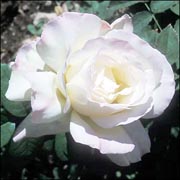

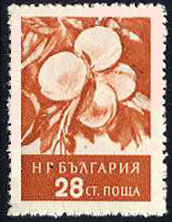 Bulgaria #938—
Bulgaria #938—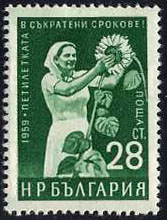 Bulgaria #1085—
Bulgaria #1085—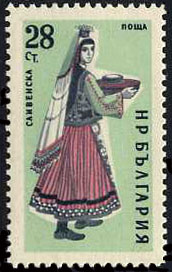 Bulgaria #1132—
Bulgaria #1132—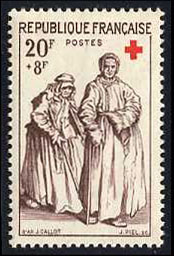 France #B319—
France #B319—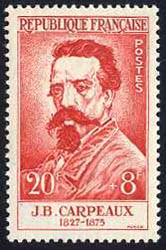 France #B325—
France #B325—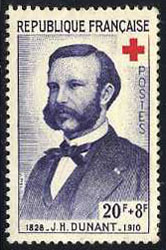 France #B328—
France #B328—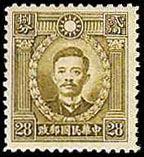 China #417—
China #417— China #467—
China #467—


